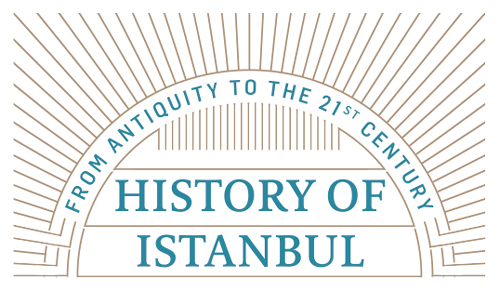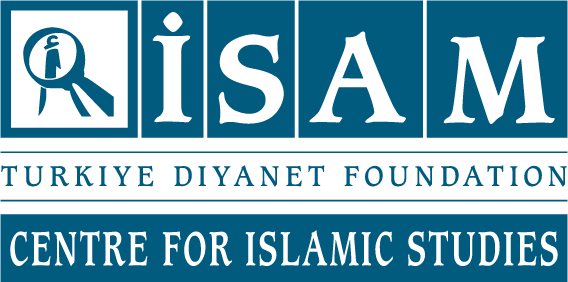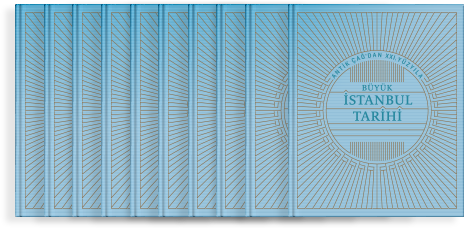After becoming the capital city of the Ottoman State, Istanbul witnessed many official ceremonies and parades. In this respect, it became a “city of ceremonies.” The official ceremonies in Istanbul, as the center of an empire that spanned three continents, had slight variations during the Ottoman period in comparison to the ceremonies in the Byzantine period. Due to its being the administrative center of the empire, the divan meetings held at the palace became special ceremonies. This was true to such an extent that the palace became the official center, followed by keen observers in various issues. Undoubtedly the divan days were of particular importance for the palace-centered ceremonies. In addition, the palace also hosted formal ceremonies, such as military processions, the departure of pilgrims from the capital, holy days and religious holidays, royal marriages, births, circumcision feasts, funerals, sword-girding ceremonies, and the Friday Processions. These ceremonies performed a wide variety of functions, including communication with people, entertainment of the city residents, revivifying social life in the city, enriching religious life, and creating a market boom; moreover, these were a means of displaying the magnanimity of the sultan, and were responses to the needs of the sultan for excursions and incognito inspections, as well as recreation, entertainment, and sports.
The Sultan’s Mounting and Incognito Inspections
The excursions made by the Ottoman sultans in Istanbul and the vicinity left a significant imprint on both daily life and the urban development of the city.
The daily excursions made by the sultans by horse or rowboat were known as biniş-i hümayun. There were two ways that the sultan mounted a horse: one was done in public in a ceremonial circle, in regular dress with his retinue, and other was done in disguise, with the sultan wearing different clothes so that he would not be recognized. It is hard to distinguish the incognito excursions from one another. However it can be said that there were differences between those excursions that were carried out for the purpose of inspecting officials, the provision of basic needs in Istanbul, or price inspection and those outings that were carried out for purposes of recreation, entertainment, worship, or parades.
The sultan usually mounted a horse in public on Mondays and Thursdays; this event was an indication of the glory of the sultan’s reign. A document from the period of Abdulhamid I clearly states the intent of the sultan in carrying out this ceremony. After a fire in 1782 that left many people homeless and caused a food shortage, the sultan ceased performing this ceremony. However, the grand vizier reminded him that Mahmud I had kept mounting his horse in public even after receiving tragic news from the border; the grand vizier requested that the sultan not refrain from performing this ceremony, and stated that people would feel more determined and hopeful if they could see the sultan in public during these difficult times.1
Although the sultan’s mounting his horse in public was an elaborate ceremony, no strict protocol was applied. The sultan would detail the direction he was heading and how he intended to mount the horse to the silahtar agha (armorer), who would accompany him along with other statesmen, such as the grand vizier, janissary agha, and çavuş paşa—in addition to the usual members of the procession like the çuhadar (footman), peyks (bodyguards), and solaks (royal bodyguards)—and the silahtar agha would issue notice of the event. After the location where the sultan would mount his horse had been determined, it would be prepared by the Enderun aghas before the sultan arrived. Unlike the other processions of the sultan, no soldiers would line the road. The residents of Istanbul could easily follow the sultan and make requests for help or complaints. In this case, the salma çuhadars would take the complainants to the mansion of the grand vizier; money would also be given to those who were in need.
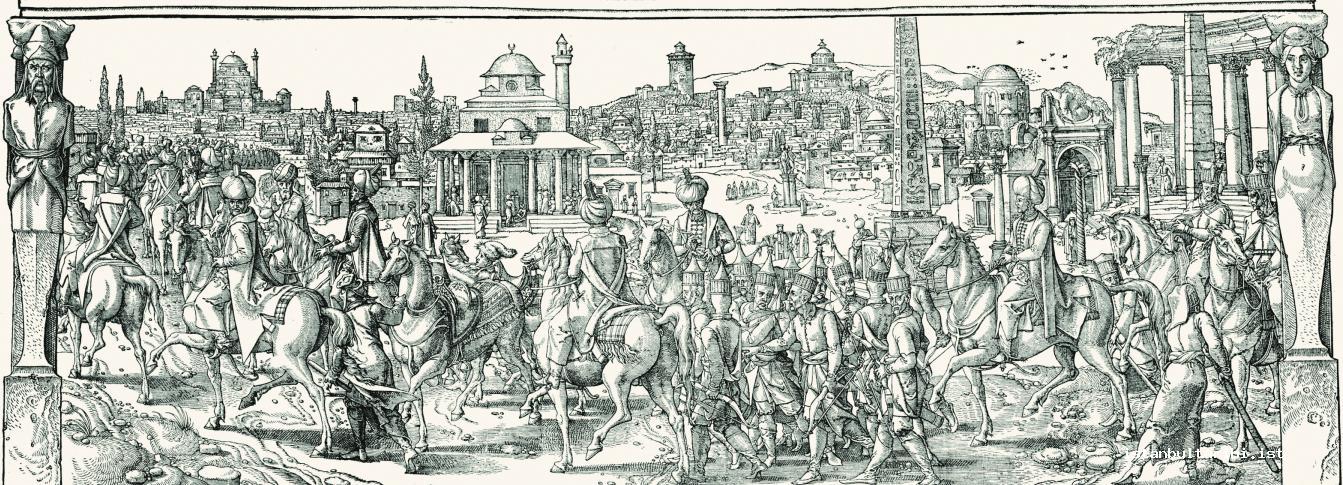
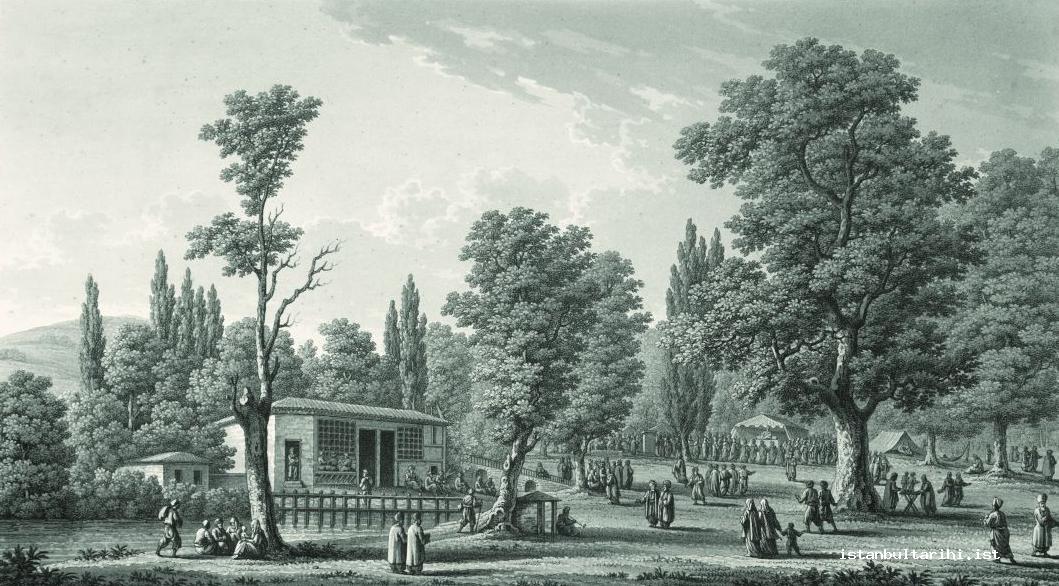
In the sixteenth century the sultans would generally use galleys known as baştarda for excursions at sea. In later times, they preferred the saltanat kayık (sultan’s rowboat). The stern of these custom-made rowboats was covered in dark red velvet, which was elaborately decorated. When the sultan would sit alone in this section, known as the köşk, the aghas would stand and hold the edge of the boat with one hand. The specially-trained acemioğlans would row standing, while the bostancıbaşı would occasionally sit to steer. This task of steering had been entrusted to the bostancıbaşı according to the kanunnâme (law code) of Mehmed II.2 A replacement boat was prepared and this would follow the sultan’s boat.
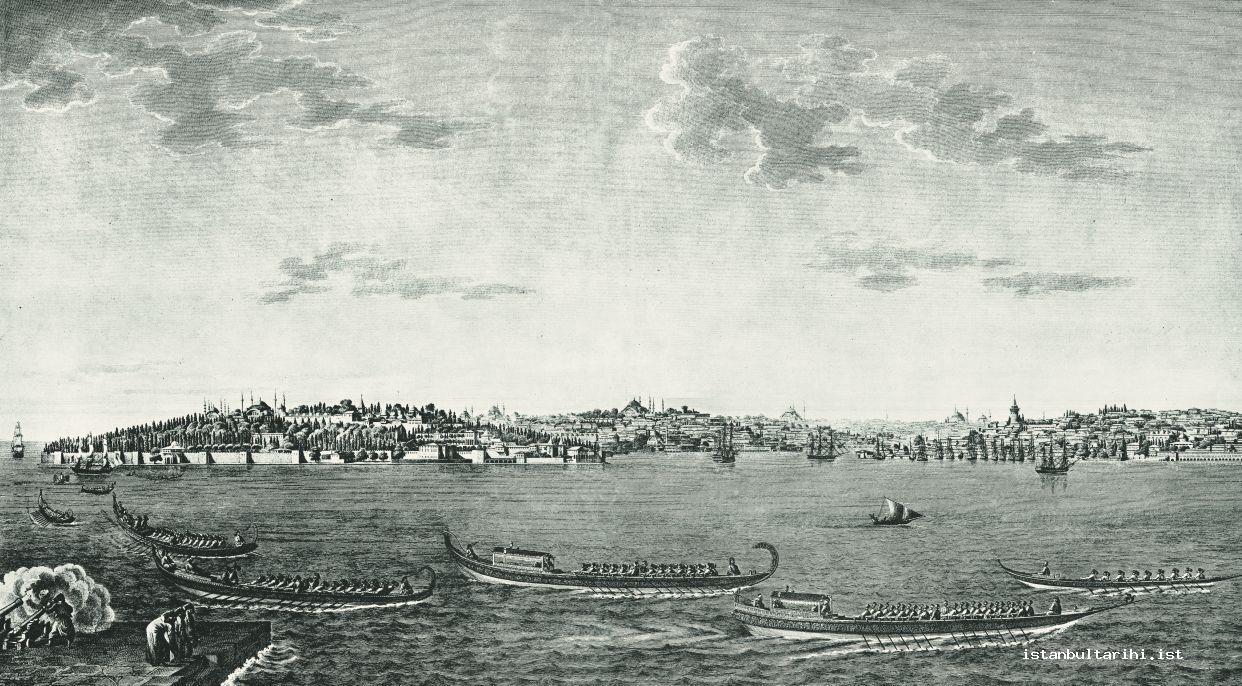
Cannons were fired from the Maiden’s Tower and the castles to announce that the sultan was about to mount his horse or board his boat. The people of Istanbul would then flock to the Bosphorus by boat. Six boats on which the içoğlans were boarded proceeded the sultan’s rowboat; the dülbent agha, who would stand on a boat that followed these boats, would greet people by presenting one of the sultan’s crested turbans first to the left and then to the right, moving it up and down, as was done in the Friday Greetings. During the procession of the sultan’s boat, the ships in the area would salute him by firing cannons.
The pier at which the sultan was to land in order to mount his horse would be covered in cloth. The sultan would mount his horse, which had been brought to this location by land; his retinue would do the same and they would go to the garden or stately home that was their destination. It was customary for the sultan to pray a sunna prayer when arriving at his destination. Then, the day’s program would commence. Sometimes they would listen to music; competitions, such as tombak, cirit, wrestling, archery, and rifle-shooting were organized; hayalbaz, acrobat, mukallid, çengi, and tavşanoğlan shows would continue until night. Sometimes, the sultan himself would shoot arrows or rifles. For example, in Gülhane in 1790 Selim III once hit an egg with a rifle at a distance of 434 feet; a monument was erected to commemorate this.3 When the festivities were finished, the sultan and his retinue would return to the palace.
Small pavilions, called known as biniş kasrı, some of which still exist in Istanbul, were built by statesmen in the locations they visited. The mansion near Davut Paşa Kasrı was constructed during the reign of Mahmud II for this purpose. The mansion in Baltalimanı was built for Selim III by Yusuf Agha, the kethüda of the valide sultan, and the Beykoz Kasrı was built for Sultan Abdülmecid by Kavalalı Mehmed Ali Pasha. This last kasır was presented to Abdülaziz when he acceded to the throne.4
Although written sources related to the sixteenth-century excursions made by the sultans in Istanbul are few, it is still possible to access some of them. According to the Venetian Luigi Bassano, who was in Istanbul between 1532 and 1540, there were generally four pleasant galleys that were decorated with gold or two-poled sailboats that were used by Suleyman the Magnificent to cross to the Asian side. Sultan Suleyman took great delight in hunting, regardless of the weather, and a large retinue would accompany him. He was also very fond of wrestling, and would organize competitions for his many salaried wrestlers; these men were employed by him, provided with special outfits, and given money prizes when they won a match.5
It is known that Selim III went on an excursion to the Bosphorus in Kılıç Ali Pasha’s baştarda, that Murad III went in İbrahim Pasha›s baştarda, and that Mehmed III, like his ancestor Süleyman the Magnificent, had a baştarda-i hümayun constructed in the shipyard in Hasbahçe; this last vessel was used by the sultan to go on an excursion with the kaptan-ı derya Cigalazade Sinan Pasha. In the seventeenth century the sultan would mount his horse in important palace gardens, known as hadaik-i hassa; these were located in Tokat, Kandilli, Mirgûn, Kalender, Sultaniye, Büyükdere, Kuleli, Üsküdar, Tersane, Florya, Kâğıthane, Akpınar, Çatalca, and Karaağaç.
Thanks to the ruznames, which concerned the everyday life of the sultans and first appeared during the reign of Mahmud I, the instances in which the sultans mounted their horses and in which they travelled around the city incognito can be closely studied. Upon examination of these records, it can be clearly understood that the sultans did not lead a reclusive life in the palace, but were actively involved in and directed the daily life of Istanbul. For example, Mahmud I would go on moonlit boat rides on the Bosphorus, thus creating a unique culture in the nightlife of Istanbul.
Likewise, with the addition of regions such as Sadabat and the Bosphorus to the urban texture of Istanbul, it is also possible to talk about an interaction between the sultan’s excursions and the attraction directed to these places. During the reign of Abdulhamid I the excursion routes were expanded to include not only the mansions, pavilions, and gardens surrounding Topkapı Palace, but also destinations on both sides of the Bosphorus, such as Dolmabahçe, Taksim, Okmeydanı, Büyükçekmece, Kemerler, Küçüksu, Beykoz, and the Camlıca Hills; thanks to this wide range of destinations, a road was formed from the coast to Büyükdere.6
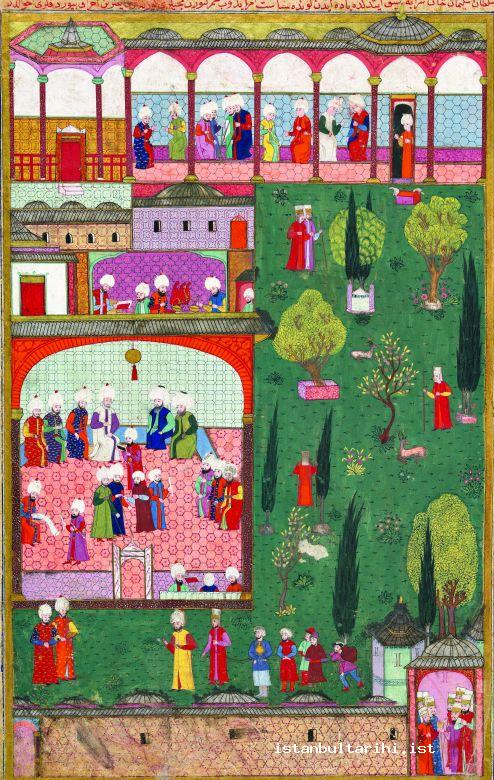
The Divan-i Hümayun Meetings and Ambassadorial Receptions
Until the middle of the seventeenth century, the Divan-i Hümayun was the main center in the administration of state affairs in the Ottoman Empire. After this date, although it gradually lost its importance in the administration, the Divan-i Hümayun was preserved as an institution of strict and complicated ceremonies until the late period of the Ottoman State.
When a meeting was planned at the Divan-i Hümayun, the Janissary agha, the aghas of the cavalry troops, and several Janissaries would take up their usual positions in front of the minaret by the Bab-ı Hümayun of Hagia Sophia Mosque at the time of the morning prayer. The divan statesmen, who usually performed their morning prayers in Hagia Sophia, would go and take up position according to their ranks. Ranking from the lowest to the viziers, who came last, they would greet each other while shouting in a manner known as alkış (applause), which was a form of reverence. When the gathering was over, the meydan duacı (public prayer leader) would pray out loud. Following the recitation of Sura Fatiha, the palace gates would open and people would enter, according to their rank.
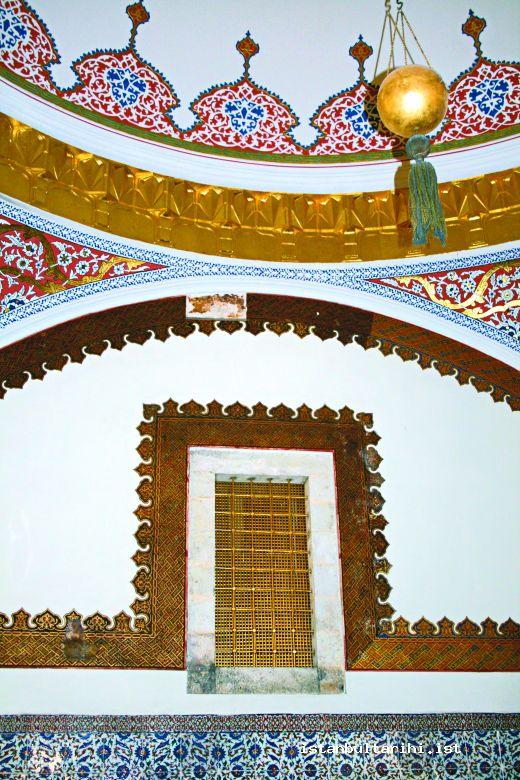
The nişancı, defterdar, and kadıaskers in the first group would not enter, but would go to the Kubbealtı and wait for the viziers. From the Ortakapı (central gate) the çavuş başı (chief of messengers/officers) and the kapıcılar kethüdası (chief of gatekeepers), headed up by the second vizier, would enter the Divanhane with the statesmen. Everybody would take their place, and wait for the grand vizier to arrive. In the meantime, depending on the season, either icy sherbet or macun (sticky candy) would be offered. Having been informed that the divan members were waiting for him, the grand vizier would come to the palace with his large retinue and dismount in front of the central gate; no one other than the sultan could enter through this gate mounted on a horse. Upon hearing that the grand vizier was coming to the central gate, those in the Divanhane would go out and form two lines. After greeting those waiting for him at the Bâbüssaâde, the grand vizier would turn back and enter the Divanhane; the others would then follow him.
Everyone would stand and would only sit only after the grand vizier broke the wax seal on the hazine (treasury) that had been presented to him. Two officials would start reciting Sura al-Fatiha in front of the hazine, and the ocak muhzır would offer sweets as a sign of the satisfaction of the kapıkulu troops with the divan members. After the recitation of the sura was finished, soup would be distributed to the Janissaries. Their rejection of the soup was a sign of rebellion; if this occurred, news would immediately rebound from the palace walls to the Istanbul streets. If such an event did not occur, the customary preparations would continue and the defters (registers) that would be used on that day were brought from the hazine and the defterhane. The reisülküttab (head scribe) would place the telhis purse on the left side of the grand vizier, the divitdar efendi would place a peşkir (linen cloth) in front of the grand vizier and put money in the purse to be distributed to the poor Muslims who came to the divan. Thus the preparations would be completed. Finally, the meeting would start with the çavuşbaşı rapping his scepter on the floor.
The meeting, which usually lasted until noon, would end when the çavuşbaşı once again tapped his scepter on the floor. A table would be set for the grand vizier, viziers, and the kadıaskers in the Divanhane. In the event of a reception for an ambassador, separate tables would be set for the nişancı (chancellor) and the defterdar (treasurer); if a large number of people accompanied the ambassador, his entourage would be seated at five tables, according to status. No separate tables were set for the officials serving in the court, as they would eat only after the statesmen had finished eating. Food would also be given to anybody who had come to settle an issue. If it was an arz günü, an audience day for presenting the decisions to the sultan, the meal was served after the announcement of the hatt-ı hümayun, declaring that the sultan would begin receiving them to present. If it was an ulufe (salary) divanı, the meal would be served after the payment of the ulufes.
If necessary, on days that were not presentation days, after the meal was over, the divan would proceed for a little longer and be concluded when nothing was left to discuss. Initially, the Janissary agha and bölükbaşıs would leave the square, followed by the kadiaskers, who would depart from the divan. The çavuşbaşı would take the imperial seal from the grand vizier, then would seal the hazine and defterhane, and then return him the seal. Everyone would stand as the seal was taken and returned. After this, the grand vizier would greet the Bâbüssaâde after leaving the Divanhane; the viziers would go outside, mount their horses, and take up position for the procession in front of the Bab-ı Hümayun. The grand vizier would pass in front of every single vizier and greet him; after this everyone would leave. If it was a presentation day, the Janissary agha, kadiaskers, and viziers would respectively be received by the sultan and then depart.
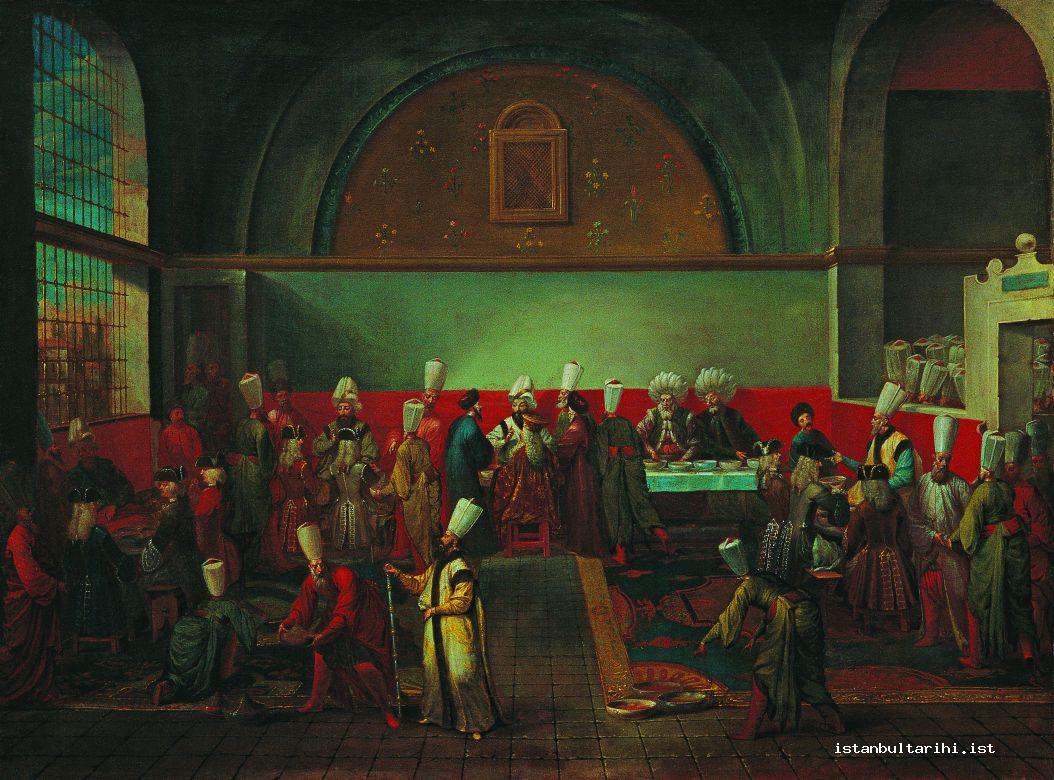
The Divan-i Hümayun would convene quarterly to distribute ulufe to the kapıkulu (sultan’s household troops); this was known as the ulufe divanı. On that day, while discussions were continuing in the Divan, the money that was to be delivered to the Janissaries was carried there in pouches. When the preparations had been completed, the grand vizier would request permission to distribute the ulufe. It was customary to serve soup, pilav, and zerde—or during Ramadan, only söğüş—to the Janissaries before the distribution of the ulufe. The food was left in front of the Bâbüssaâde; upon a sign made with the skirt of the başçavuş’s coat, the janissaries waiting at the central gate would run and take up the food, eating it in the courtyard. After the meal, they would reconvene in front of the central gate. The başçavuş would pray there out loud, calling out the word hu, and all the Janissaries would respond with a collective hu; after this the ulufe would be distributed.
Ambassadors visiting Istanbul would initially be received at the Kubbealtı and then in the Arz Odası (Audience Hall), if this was his first visit. The divan established for the reception of the ambassadors was known as the elçi divanı. Ambassadors were invited to the Divan-ı Hümayun on arz günleri to present letters from their rulers. However, if the situation was not urgent, the ambassador would generally be invited to the ulufe divan, allowing him to view the magnificence of the Ottomans with his own eyes. The distribution of the ulufe and the reception of ambassadors at the ulufe divan were both referred to as the büyük divan or galebe divan.
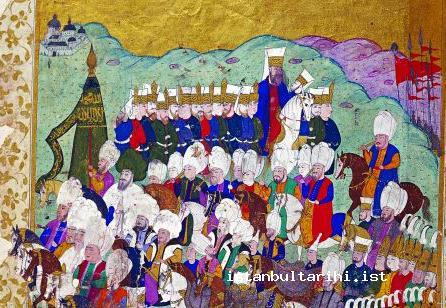
The locations to which the ambassadors would go, particularly the Kubbealtı and Arz Odası, would be adorned with carpets, valuable items, and jewelry. If the ambassador’s residence was in Istanbul, horses and some çavuş would be sent to accompany the ambassador and his entourage to the palace; if he was staying in Galata they would be sent to the Bahçekapısı Pier to meet him. Passing by the Alay Pavilion, the ambassador would dismount his horse at the central gate, rest a little in the kapıcıbaşıs’ room, and after being received in the second courtyard, he would be taken to the Kubbealtı, in the same way that the Janissaries were going to get pilav and zerde.
If the ambassador was not Muslim, the grand vizier would go into the Divit Odası before the ambassador arrived at the Divanhane, thus avoiding having to stand up when the ambassador entered. The grand vizier would enter just as the ambassador arrived. When the grand vizier entered the room, the Divan statesmen would stand up. Although the ambassador might think this was a show of respect for him or his ruler, the Divan attendants were actually standing up for the grand vizier. This procedure was not followed if the ambassadors were from Muslim states; the grand vizier would wait in the Divanhane and everyone would rise when the ambassador entered. After the distribution of the ulufe had been completed, the ambassador would dine with the grand vizier, and his entourage would dine with the others. After dinner, the preparations for the ambassador to visit the sultan would be completed in the Arz Odası.
The reception of the ambassador would be observed according to normal audience days. The ambassador would wait in the Bâbüssaâde until the Janissary agha and the kadıaskers had exited; he and his entourage would be dressed in hilats (robes). When it was the viziers’ turn to present, two kapıcıs would accompany the ambassador and his entourage, and in this manner they would be received in the Arz Odası, where they would bow to the sultan. In order to see the sultan, the ambassador had to bring letters addressing the sultan and presents from his ruler. The letters submitted to the miralem agha would be given to the grand vizier by the viziers, who were arranged according to seniority; the grand vizier would place the letter on a cushion next to the sultan. The sultan’s letter was delivered to the ambassador in the same way. If the sultan had something to say to the ambassador, he would address him directly; if he was not going to say anything, a signal would be given and the ambassador would be taken out.
Farewell and Welcoming Ceremonies for the Army on Campaign
When the Ottoman army was leaving for campaign, official ceremonies and public celebrations in Istanbul were carried out in various ways, such as the unveiling of tuğs (crests) and the Sancak-ı Şerif (blessed banner), the establishment of the military encampment, the bidding of farewell to the army, and the welcoming of the army after the campaign.
The sultan-led military campaigns, known as sefer-i hümayun, and the sending off of the army in these periods were very elaborate. The first ceremony upon making a decision to embark on a sefer-i hümayun was the unveiling of the sultan’s two tuğs at an auspicious time, as determined by the müneccimbaşı (court astronomer). All the statesmen, in particular the viziers and sheikh al-Islam, would attend this ceremony; they were notified by written invitation one day in advance, and would stand in official dress at the central gate.
After everyone had taken their place on the day of the ceremony, the grand vizier would come to the palace in a procession. Upon the proclamation by Enderun that the tuğs were ready, they would be brought in front of the Bâbüssaâde. After the recitation of Sura al-Fatiha, one of the sheikhs would be invited to pray; finally the tuğs were brought out of the Bâbüssaâde by the arzağas. The tuğ on the right side would be taken by the grand vizier and the tuğ on the left side was taken by the sheikh al-Islam; they were placed in containers in front of the Cebehane (artillery), Bab-ı Hümayun, central gate, and the Bâbüssaâde. The ceremony ended in the palace with a prayer led by the naqib al-ashraf or sheikh al-Islam. On the same day, the grand vizier and others who had tuğs would set them in the Sublime Porte and on the stairs to their mansions, thus notifying the residents of the city that a military expedition was to take place.
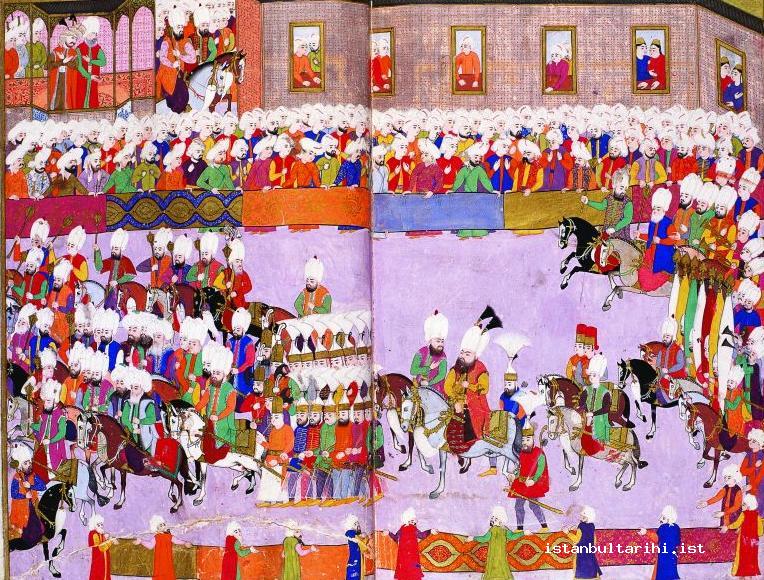
A few days after the unveiling of the sultan’s tuğs, the statesmen, led by the grand vizier, would select the place in which the otağ-ı hümayun (imperial pavilion) would be erected. They would go to Davutpaşa, Çırpıcı Çayırı, or Üsküdar, depending on which direction the military campaign was to take. The transfer of the tuğ and otağ-ı hümayun to the encampment was carried out with a ceremony. The tuğs of the statesmen who were to join the campaign were brought to the Sublime Porte early in the morning by the tuğcus; all would proceed to the palace accompanied by the mehter. First, the sultan’s tuğs and then the otağ-ı hümayun would be taken from the barrack tents of the mehter to the army encampment in a procession. The Istanbul artisans who had been appointed to go on campaign with the army would meet in the courtyard of the Blue Mosque, and on the following day they would enter the encampment following a great procession in which the tuğs were unveiled.
The most exhilarating day of the farewell ceremony was the day when the “grand procession” took place. Statesmen gathered in the palace to organize the procession and the removal of the Sancak-ı Şerif. The Sancak-ı Şerif was sent to the encampment via a different route before the procession. In the palace, Sura Fath would be recited by the fetihhans, and one of the sultan’s sheikhs would pray for victory; after this, the sultan would leave via the Bâbüssaâde. Those who were waiting would immediately take up their place in the procession; they would march to the encampment, accompanied by the praises and prayers of the people who had flocked to the streets, all the while accompanied by the mehteran. Sheep were sacrificed on the roads, squares, and streets through which the sultan passed.
If the grand vizier was to go on campaign, the sultan would send a hatt-ı hümayun and a jewel-studded sword. The statesmen would dress up in hilats as a sign of their joining the campaign, and the sultan would present them with horses. Statesmen would also be present at the ceremony in which one of the grand vizier’s tuğs would be raised in front of the Sublime Porte. There would be more processions, both for the designation of the location of the otağ and for the delivery of the grand vizier’s tuğs to the encampment; however, these processions were not as well attended as the sultan’s processions.
From the end of the sixteenth century, it became customary to take the Sancak-ı Şerif on campaign. Thus, a special ceremony was created for the delivery and return of the Sancak-ı Şerif to the serdar-ı ekrem. On the day of that the sancak was handed over, the statesmen would gather in the palace early in the morning; the grand vizier would be the last to arrive with the kapıhalkı (the retinue of the grand vizier) and the mehteran. The sultan himself would remove the Sancak-ı Şerif from the chest in the Hırka-i Saadet room; generally the sancak would be delivered to the grand vizier here, however, sometimes this would be done in the Arz Odası. The grand vizier would bring the Sancak-ı Şerif and put it into the container prepared for it; Sura Fath would be recited, and, accompanied by a great procession, the sancak would be taken to the encampment. Upon arriving there, the grand vizier would put the sancak in the tent that had been erected to protect it.
When the army returned from the campaign, it would be greeted with a ceremony in the capital city. When returning from Rumelia, the sultan would enter the city from Topkapı or Edirnekapı. When a campaign was under the command of the grand vizier or one of the viziers, the sultan would come to Davutpaşa to meet the army; following this visit, he would return to the city without waiting for the army. Entering Istanbul with a great procession, the grand vizier would arrive directly at the palace and return the Sancak-ı Şerif, which he had been carrying on his shoulder from the central gate of the palace, to the sultan. The ceremony to greet the sultan and serdar-ı ekrem when returning from expeditions in Asia was generally held in Üsküdar; they would usually go to the Eyüp Pier from there and return to the palace with a grand procession from Edirnekapı.
In the periods when the expeditions culminated in a victory, many sources show that both the return of the army from the campaign and the news of their victory would create a festive atmosphere in the capital city. Luigi Bassano states that when Suleyman the Magnificent returned from a campaign, he was greeted by all the residents of the city, that the shops stayed open for three days and nights, and that the people feasted continuously during this period of celebration.7 As a matter of fact, owing to the return of Sultan Suleyman I from the Austrian campaign in 1532, which is referred to as the Alaman seferi, the bazaar and markets—mainly the Bedesten—were kept open and banquets were arranged to celebrate the army’s victory.8 Osman II also organized festivities for three days and nights in Istanbul after his return from the Khotyn campaign; however, during the festivities the infant son of the sultan, Ömer, was hit by a stray bullet, thus this overshadowed the joy.
Once the news that Murad IV had conquered Revan reached Istanbul, the kaymakam Bayram Pasha had cannons fired from the Saray Pavilion and declared a celebration that would last four days and nights. In addition, he had the city walls of Istanbul, the Galata Tower, and Tophane repaired and painted white. Upon the arrival of the sultan in Istanbul, a nonstop festival was organized for another week. The news of the conquest of Baghdad was celebrated with a festival that lasted for twenty days and nights and cannons were fired in the capital city. Murad IV organized a week-long festival upon his return to Istanbul. The residents of Istanbul hung two lamps, with some hanging as many as ten, on their doors in celebration.9
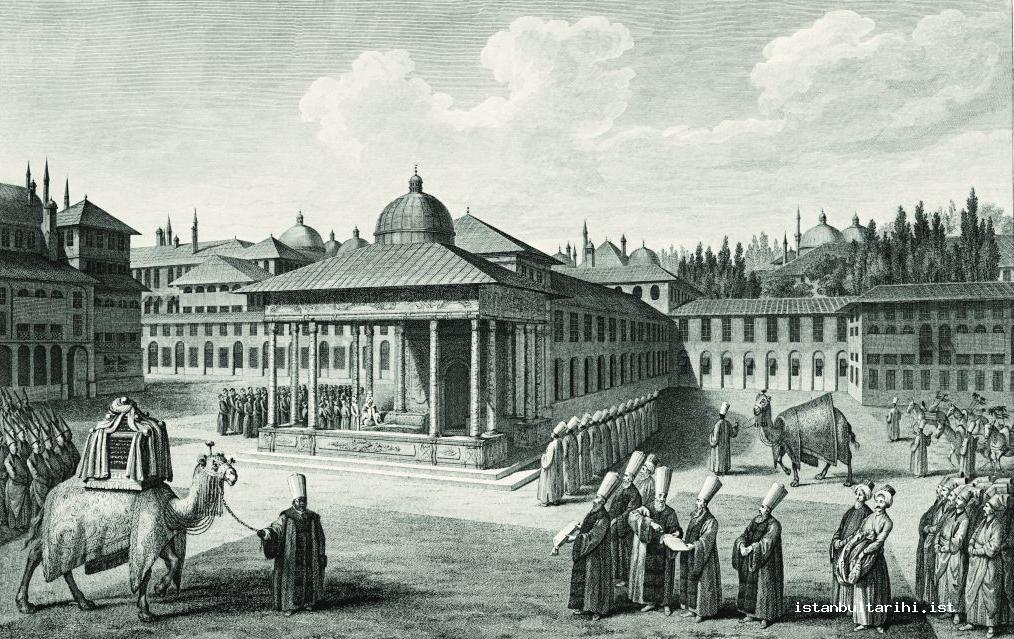
The Ottoman navy setting sail became an annual custom during the rule of Bayezid II; this custom continued until the mid-nineteenth century. A ceremony was held both for the departure and the arrival of the navy. These ceremonies were usually conducted in the presence of the sultan, who would be in the Yalı Pavilion. The kaptan-ı derya (grand admiral) would enter into the sultan’s presence with the grand vizier and be dressed in a hilat (robe of honor). Following the death of Barbaros Hayreddin Pasha and his burial in the tomb in Beşiktaş, it became traditional for the navy to visit the tomb immediately after the ceremony in the Yalı Pavilion. The navy would moor there for no more than three days. They would visit Hayreddin Pasha’s tomb, sacrifice sheep, pray for the campaign to be victorious, and hold banquets for the statesmen in tents set up in Dolmabahçe. Upon the return of the navy to Istanbul, another ceremony would be held in the Yalı Pavilion; the sultan would participate in this ceremony. In addition to these, there was a ceremony marking the launch of newly completed galleys, which would also be attended by the sultan.
The Surra Procession
The word surra, meaning “purse,” is also used to refer to the money that the sultan would send to Mecca and Medina every year during the Hajj season. In addition, the sultans would send gifts, known as surre-i hümayun, to the Haramayn; these gifts included hilat, kaftans, and food. These would be distributed to the notables of the region, the seyyids and şerifs who resided in Mecca and Medina, the poor and pilgrims, and the Bedouins en route; this latter group was given gifts to prevent them from robbing the pilgrims. In addition, mahmil-i şerif (covers and a band for the Kaba) and covers for the Rawza-i Mutahhara (the tomb of the prophet) and for the tombs of the Companions would be sent with the surre.
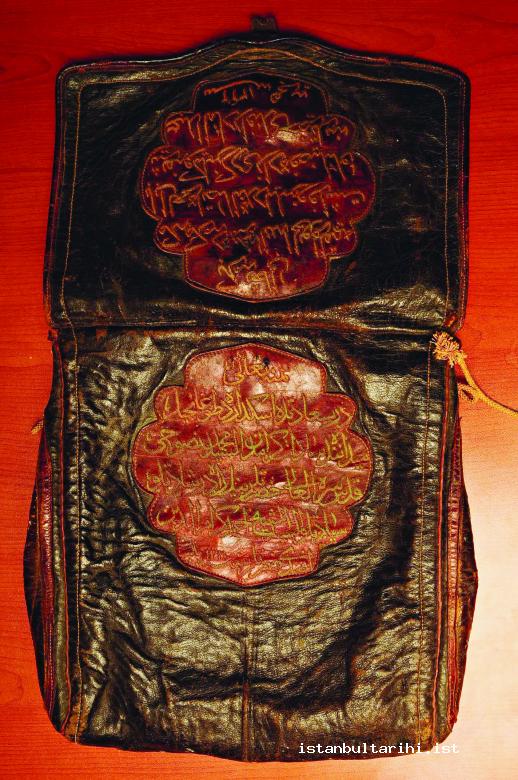
The tradition of sending gifts and money to the people of Mecca and Medina started during the reign of the Abbasids and continued during the subsequent Muslim states. The first known surre from the Ottoman State was sent by Sultan Bayezid from Edirne. Starting as a token of respect, this tradition continued in Istanbul after its conquest. When Sultan Selim I conquered Egypt in 1517, the Haramayn came under the rule of the Ottomans; to mark this, the Sharif of Mecca sent his son to the sultan with the holy relics and the key to the city. When the Hijaz passed into the hands of the Ottoman administration, the Ottoman sultans were awarded with the title Khadim al-Haramayn al-Sharifayn (Servant of Mecca and Medina); as a result, they undertook the Hajj organization for the entire Muslim world. Thus, from the era of Sultan Selim I until the fall of the Ottoman State, with a few exceptions, the surre was sent regularly every year. Some years the expenses for the surre were met by taking loans.
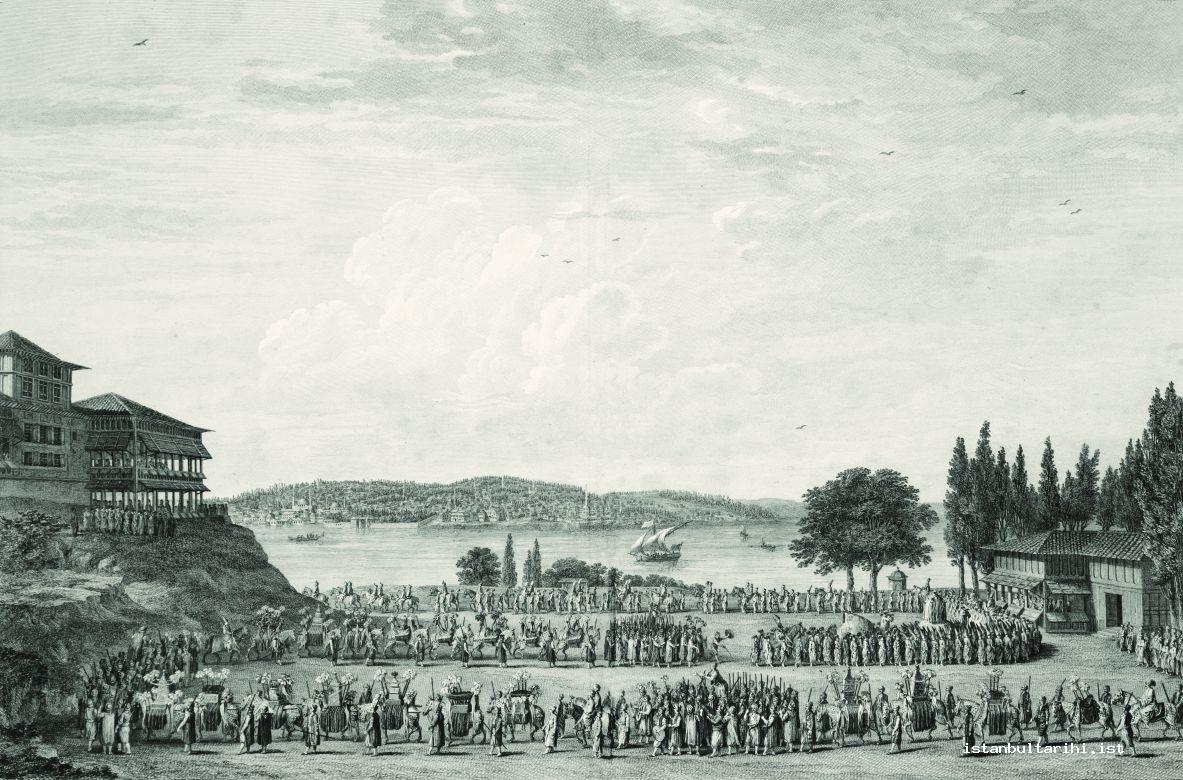
The surre procession was sent off from Istanbul with a spectacular ceremony. The preparations would begin months in advance, and orders regarding the safety of the pilgrims would be sent to the governors en route. One of the leading statesmen would be appointed as the surre official. The official was in charge of delivering the surre to its destination safe and sound. Moreover, he was obliged to take gifts from the people of Istanbul in feraşet (sweeping) pouches as well as the sultan’s gifts; in return for these he would bring gifts from Mecca in the same pouches. Written on one side of the feraşet pouches was the name of the sender, while the name of the recipient was written on the other side.
From 1587 onwards, the responsibility of preparing the surre procession rested with the Darüssaade agha. In 1836, this duty was given to the Haremeyn Evkaf Nezareti (Ministry of Foundations of Haramayn). Due to the long distance and inadequate transportation, the surre procession would be sent off from the palace in Istanbul on the twelfth of Rajab. Those participating in the ceremony would be invited to the palace the day before; and the kaptan-ı derya would be asked to keep the çektiri ships that were to transfer the procession to Üsküdar ready at the pier in Eminönü. Certain areas of Topkapı Palace would be adorned for the ceremony with exquisite fabrics. In the past, the surre ceremonies were held in the palace of Mehmed III. In later times, the ceremony was usually held in the İkinci Avlu, particularly in the Kubbealtı. A tent would be set up across from the Kubbealtı; here the surre pouches and other objects would be placed. In the eighteenth century, the otağ-ı hümayun was used for the sultan and some other tents would be erected for the statesmen.
The guests who arrived at the palace on the following day were first received in the Divan Room by the Darüssaade agha; the first ceremonies were held here. Upon hearing the news that the sultan was about to arrive, the guests would get ready to welcome him. The sultan would leave the Bâbüssaâde on horseback and wait in the place of the nişancı (chancellor) in Kubbealtı. After the surre pouches were counted and the registers were sealed in the tent, the Darüssaade agha would approach the sultan with a surre official and submit the surre registers and the name-i hümayun to the surre official. As verses from the Qur’an and prayers were recited, and naats (hymns praising Prophet Muhammad) were sung, a she-camel was loaded with the mahmil-i şerif and paraded around the square together with the camel that would be her replacement. Then, the Darüssaade agha took the camel around; at the end of the third tour, upon a sign from the sultan, the agha would hand the silver chain leading the camel to the official and the camel’s silk halter to the sakabaşı. If a sign from the sultan was not given, this meant that the agha had been dismissed, and he would leave for Mecca with the surre procession.
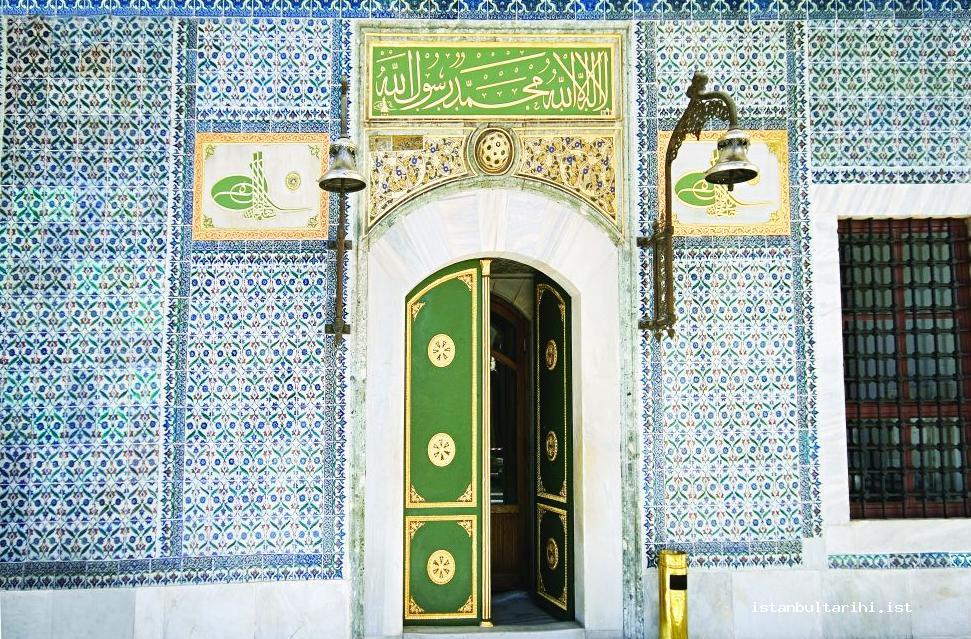
The camel carrying the mahmil-i şerif was not used for any other purpose. When she was unable to travel anymore, she would be housed in the palace stables until her death. The mahmil-i şerif was sewn, and verses from the Qur’an, prayers, and the sultan’s name were embroidered on it. When necessary, the mahmil-i serif was replaced and the old versions were sent back to the palace. According to the sources from the late Ottoman period, the mahmil-i şerif was taken by the Darüssaade agha to the harem prior to the journey; here it was visited by the valide sultans, the kadınefendis (consorts of the sultan), and kalfas (ladies-in-waiting). Two former kalfas would festoon the mahmil-i şerif with fabric that had been given by the valide sultan and the kadınefendi. On the day of the ceremony, the camel that was loaded with the mahmil would be decorated with henna and special fabrics. In fact, the phrase “like a surre camel” was used in Istanbul to refer to overdressed women. The camel represented the Prophet’s camel and the mahmil-i şerif represented the mahmil that carried the Prophet and his family; the camel was deeply respected both in Istanbul and in the areas the procession passed through.
Once the ceremony in the presence of the sultan had come to an end, a procession began from the central gate. The surre official would proceed on horse at the head of the procession, carrying the name-i hümayun that was being sent to the Sharif of Mecca; the rest would follow. The palace aghas and the Darüssaade agha—if he had not been stripped of his rank—would say farewell to the procession and return to the palace. The procession would make its way through the city and approach the pier from the Alay Pavilion, through Hocapaşa and Bahçekapı; from here the procession would be transferred to the waiting ships, and thus the procession would end.The surre was welcomed in Üsküdar with an official ceremony. The procession passed through the crowd that had gathered in the square to the mansion of the qadi; from here it went to the residence of the mutasarrıf, where it would remain until the day of departure. The tombs of Aziz Mahmud Hüdayi and Nasuhi Efendi would be visited; at the same time, this gave an opportunity for those who were delayed to catch up with the procession, and the final preparations could be made. On the day of their departure from Doğancılar, the public and statesmen would join the surre procession at the time of morning prayer. Following the final farewells, the surre procession and the pilgrims would depart for the Haramayn.
Until 1864, mules and camels would go with the procession; after this date the surre procession began to travel by sea. With the construction of the Hijaz railway, the procession made the journey by rail. As these developments shortened the travel time, the procession now departed on the fifteenth of Shaban; in addition, after the residence of the sultan was moved from Topkapı Palace, the ceremonies and processions were held in the other palaces. A private room in Dolmabahçe Palace was used for the preparation of the surre; the sultan watched the procession from here. An innovation in this period was the inclusion of a thirteen-gun salute and military band in the protocol during the transfer of the surre to Üsküdar.
When in Kartal, on the return from the Hajj, the surre procession would ask for permission to come to Üsküdar; when permission was granted the procession set off and was welcomed with a ceremony. From Üsküdar the procession was transported to Eyüpsultan by ship. On the following day, the mahmil-i şerif would be set up again by the palace officials, the ulema, and sheikhs; the procession would enter the city from Edirnekapı. The surre would reach the palace accompanied by takbirs, prayers, and the tears of the crowds who had gathered in the streets; statesmen would wait for the mahmil-i şerif at the central gate and then take it to the sultan. It was traditional for the Sharif of Mecca to send the cover of the Kaba to the capital with the surre procession in order to congratulate the new sultan on his accession. Some mahmil-i şerifs were stored at the palace and small pieces were given as gifts to statesmen.
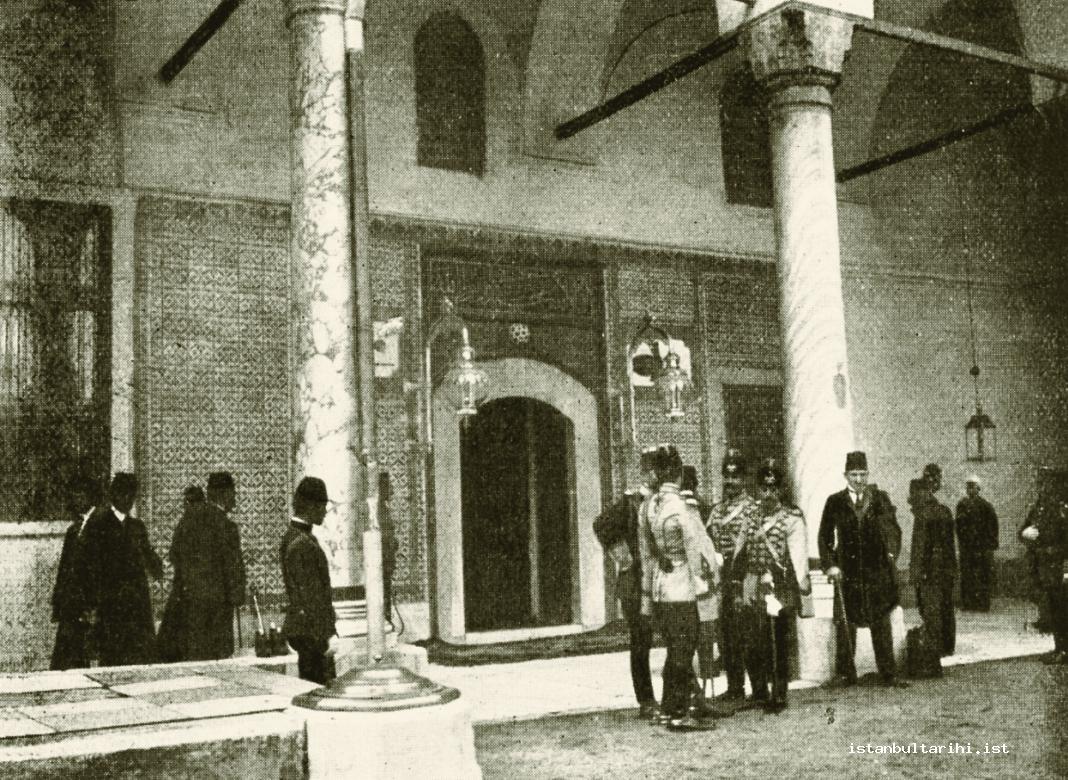
The Visit to the Mantle of the Prophet and the Baklava Procession
During the reign of Sultan Selim I, the Prophet’s mantle, which is thought to have been inherited from Ka’b bin Zuhayr, was brought to Istanbul, thus creating a spiritual atmosphere in the palace.
It is known that the sultans visited the mantle of the Prophet for various reasons during the sixteenth and seventeenth centuries. They would sometimes take the mantle with them on different expeditions, military and otherwise. Visiting the mantle of the Prophet during the month of Ramadan became a palace tradition and from the early years of the eighteenth century this tradition was marked with an official ceremony.
The visits made to the mantle of the Prophet during Ramadan made a strong impression on the life and folklore of Istanbul. According to a custom rumored to have been started by Ahmed I, a piece or a button of the Prophet’s mantle would be washed in zamzam by the sultan in a golden bowl and be immediately dried in amber fire. Water was then added to this, and the resulting mixture was put into bottles to be presented to state officials. It was strongly believed by the people of Istanbul that this water, referred to as ma-i mübarek, cured fears and illnesses. Some herbalists even sold sealed bottles of water which they claimed to be ma-i mübarek.
Without mentioning a date or ceremony, Ali Ufki narrates that the mantle of the Prophet was immersed in the rainwater that was collected in April particularly for this purpose by the kilercis; the mantle was then wrung out. Ali Ufkî also states that water which had come into contact with the mantle was put into bottles and given to officials both in Istanbul and in other locations; those who received these bottles took special care of them. Ufkî adds that the potion, believed to be an elixir, was given to those who suffered from inflammatory diseases and drops of it were placed in the mouths of dying people, as it was believed that this cleansed them of their sins.10
In his book published in 1675, the French traveler Tavernier writes that “two men in the treasury,” referring to the içoğlans, would clean and change the carpets of the Has Odası (Privy Chamber) every three months and inspect the mantle. In addition, he mentions a “washing ceremony” held on the fourteenth of Ramadan, which was attended by the sultan. According to Tavernier, only the silahdar agha would accompany the sultan into the room; the sultan would emboss fifty pieces of paper with the Prophet’s preserved seal, take the mantle out of the chest that protected it, and kiss it respectfully. Afterwards, the mantle was dipped into a golden tub filled with water, and being careful not to drip any water on the ground, the mantle was gently wrung out in the tub. The water from the tub was put in bottles made of Venetian crystal, which were then tightly sealed. The tuğra of the sultan was put on these bottles.
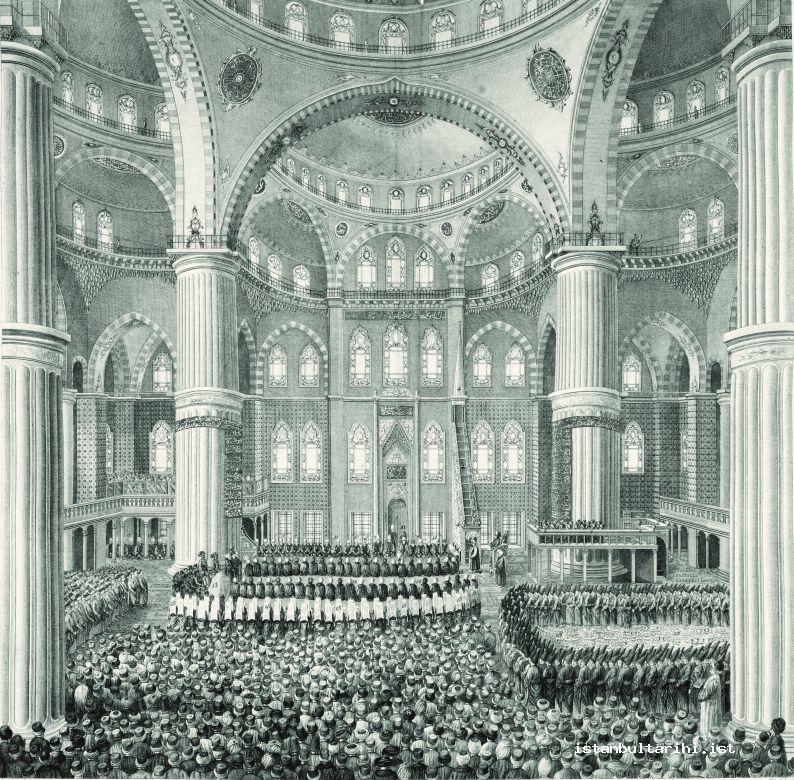
A small piece of paper was rolled up and tied with silk to the bottles; the next day they were sent to the women of the Harem, Istanbul officials, and statesmen. Sometimes just the bottle would be given as a gift. This was considered to be a great blessing and gifts were presented in return, either to the sultan or to the person who brought the gift. Without unrolling the paper, it was soaked in the water from the bottle and then swallowed, and then the water was drunk. Those people who only received a bottle repeated the same process while dictating their own prayers to an imam. According to Tavernier, adding water to the water that had touched the mantle and the distribution of the same by the Kapıağası only occurred over three days.11
After visits to the mantle became a part of state protocol, until the mid-eighteenth century this ceremony was held on any day in Ramadan; in the nineteenth century it was held on the fifteenth of Ramadan, if this day did not fall on a Friday, and if the sultan was in good health.
Two days before the ceremony, the pages of the Has Odası would move the mantle to another part of the palace while reciting the takbir, cleanse the room with rose water, and return the mantle to its place either on the day of the ceremony or the day before. On the night before the ceremony, a final cleaning would be carried out; the sultan himself participated in this, and he performed the morning prayer in the room. Sometimes, the final cleaning would be done following the prayer. The sponges used to clean the mantle and the room were distributed among the aghas of the imperial household as gifts. The dust that was removed from the room was thrown into a well nearby that was dedicated to this purpose.
On the day of the ceremony, the invited statesmen, meşayih, and the ulema would come to the palace following the noon prayer in the Haghia Sofia Mosque and gather in front of the Bâbüssaâde. The grand vizier would come to Haghia Sofia from the Sublime Porte with his retinue, and would perform the noon prayer with the sheikh al-Islam before departing for the palace. Sometimes the guests would gather at the Sublime Porte and leave for the palace together. After everyone was present in the room, the first and second imams would recite one aşr-ı şerif. After the recitation, the sultan would open the chest in which the mantle of the Prophet was preserved with his own hands and would first rub it across his face and then would present the mantle to the others according to their rank for them to do the same. This part of the mantle was wiped with a small cloth and the cloth was presented to the sultan. After everyone had rubbed their faces on the mantle, it was placed back in the chest and the visitors would disperse.
After the visits to the Prophet’s mantle had become formalized, some measures were put in place to protect the mantle. Instead of the using the mantle itself, a cloth placed on the right side of the collar was used and this cloth was presented as a gift. Only one part of the bundle covering the mantle was dipped in water instead of an arm or a button, to prevent it being damaged. During the reign of Mahmud II, this tradition and the distribution of the “holy water” was completely abandoned. A new tradition was implemented, in which specially prepared cloths had poems about the mantle written on them and were given as gifts.
In the nineteenth century, when the sultans began to reside in palaces other than Topkapı, a procession would be organized for the visits to the mantle of the Prophet; this ceremony was partially open to the public. The procession would meet the sultan, who either followed the coastal road to Galata Bridge or arrived at Sirkeci by boat, and it would continue from there. The noon prayers were performed in Hagia Sophia and the procession would then continue to the palace. The school children of Istanbul also participated in the procession. At the beginning of his reign, Abdulhamid II would have his iftar in Topkapı Palace after this ceremony; he would then return to Yıldız Palace in a lantern-lit procession, with soldiers lining the road. In later years, he would return to Yıldız in the mid-afternoon.
During the reign of Abdulhamid II, members of the harem came to the palace in a car; the valide sultan, who also visited the mantle, led the procession. After the statesmen left, the women of the harem accompanied by the sultan would visit the mantle. Moreover, during the years when the sultan left Topkapı Palace after the iftar, mahyas (lanterns hung during the month of Ramadan to spell out a phrase) which stated “Long Live the Sultan” were hung from the mosques.
From the end of the seventeenth or the beginning of the eighteenth century, the city of Istanbul was enlivened by another ceremony that marked the visit to the mantle: this was the Janissaries’ baklava procession. That day, hundreds of trays of baklava wrapped in futa (towels), calculated as one for every ten soldiers from the kapıkulu barracks, would be lined up before the Matbah-ı Amire (Imperial Press). The first tray would be taken by the silahdar agha to be given to the sultan, who was the head Janissaries. Then, two people would grab a tray from the center. The commanders of the squad would lead them, and they would enter their barracks to the applause of the residents of Istanbul, who were lined up on both sides of Divanyolu. Trays of baklava and towels would be delivered to the palace on the following day. The last baklava procession was held two months before the abolition of the Janissary corps. Visits to the mantle and the procession continued until the collapse of the empire.
The Celebration of the Birth of the Prophet and
the Night of Qadr
The twelfth of Rabi al-Awwal is considered to mark the birthday of Prophet Muhammad, and this day was celebrated by the Ottomans with an official ceremony. This tradition was common in many other Islamic states prior to the Ottomans.
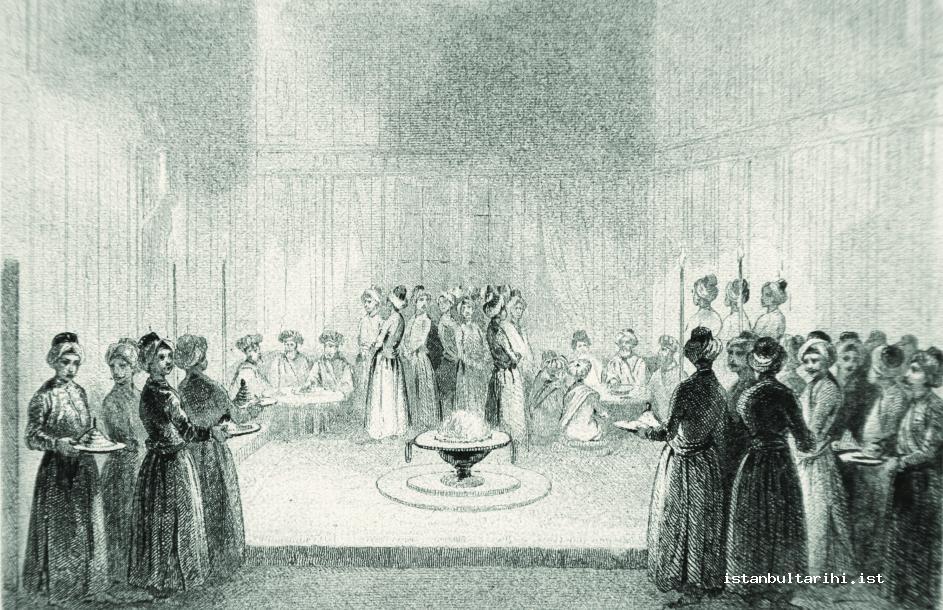
There is no exact information in the sources regarding when the official birth celebration began. Upon examination of these sources, it can be understood that the Prophet’s birthday celebration became a practice during the reign of Suleyman the Magnificent, and was made an official part of the protocol during the reign of Murad III; the latter ordered that all the minarets be lit with candles and memorial prayers for the Prophet be recited in the mosques and masjids.
The official preparations for the celebration would commence when the qadi of Istanbul announced that the month of Rabi al-Awwal had begun. Messengers would deliver the letter of the emirülhac and the epistle from the Sharif of Mecca announcing that the pilgrims had reached Damascus safe and sound. The letter and epistle would be put into satin bags in the presence of the grand vizier to be submitted to the sultan; the palace would be notified of this with a report. A few days before the celebration, the sultan would be asked which mosque he planned to go to and what time the ceremony should take place; upon his reply, a note including this information would be sent to the participants.
In the event that the sultan could not attend the celebration or that the messengers did not arrive, the official ceremony would be postponed until a convenient date, with only the public ceremonies taking place. However, if it was clear beforehand that the messengers were not going to arrive, the ceremony would still be held. For example, the sultan went hunting in 1686 and was ill in 1691; both times the celebrations were postponed. In 1757 the pilgrimage convoy was plundered so the messengers did not arrive, but the official celebration was still held. The official ceremony was conducted at first in Hagia Sophia, and later, after the construction of the Blue Mosque, it was held there; however, sometimes the sultan would choose another mosque. No matter where the ceremonies were held, the waqf that Ahmed I had established for this purpose would meet the costs of the sweets and sherbets served on this occasion, as well as the cost of the presents and hilats (robes of honor) for those who recited special poems at the ceremony.12
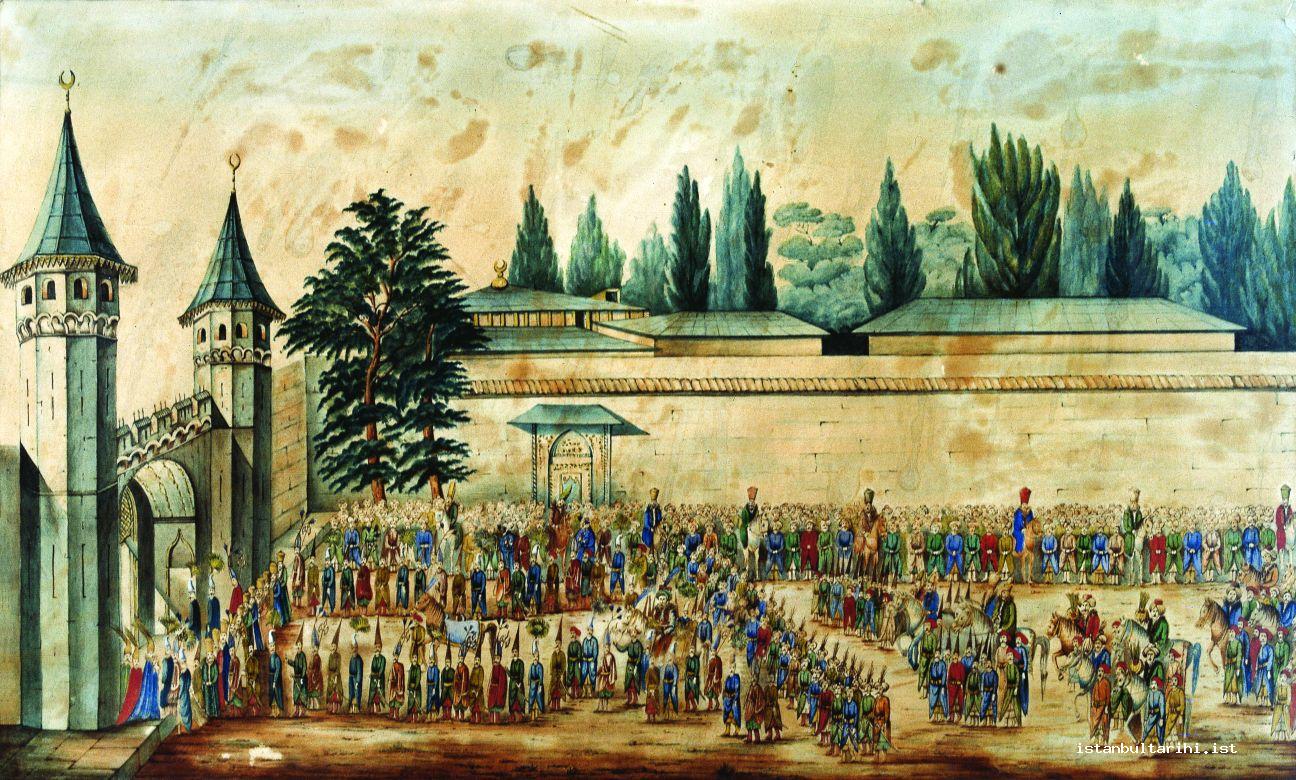
On the day of the memorial recitation, those who had not been sent an invitation would arrive early in the morning, while those who had been invited would arrive at the mosque in their ceremonial robes at the specified time. Once the state officials had taken up position in the mosque, the grand vizier, or in his absence, the sadaret kaymakamı, would arrive in a procession with the statesmen of the Sublime Porte and sit on the prayer rug in the mihrab; the others would sit in circles around him. After everyone had taken their places, Sura Fatiha would be recited. In the meantime, the sultan, who had left the palace to proceed down roads that had been covered with sand, would come to the mosque and enter the mahfel-i hümayun (imperial loge). The bars of the mahfel would be opened to signal that the sultan had arrived and everyone would stand up. After the grand vizier and sheikh al-Islam saluted the sultan, the bars would close again and everyone would sit down.
The sheikh of the Hagia Sophia, the sheikh of the Blue Mosque, and the nobetçi sheikh would one by one sit on the pulpit and preach to the community; while they were doing this, people would drink sherbet and receive incense. Once the preaching was over, epics about the life of the Prophet would be recited. When the part that reads “a set of white-winged birds came / they patted on my back mightily” was recited, the congregation would stand. At this time, the grand vizier would take the epistle from the Sharif of Mecca and a letter from the emirülhacc from the messenger and send them to the sultan via the reisülküttab. The reisülküttab would read the letter aloud to the sultan and return to his place. The dates sent from Medina to the sultan were served to the statesmen starting from the grand vizier. As the third person was reciting, the waqf trustees would serve sweets to the community. At the end of the mevlid, everyone except for the statesmen would go home. The state officials would line up in a procession in front of the mosque to wait for the sultan. The sultan would return to the palace after leaving the mosque and greeting those who were waiting for him. The grand vizier would then return to the Sublime Porte with his retinue.
Although there were some changes to the mevlid ceremony and procession in the nineteenth century, the essence was preserved. At night, the celebrations were enhanced with lanterns to adorn the city and the firing of guns in salute, and they continued until mid-afternoon the following day. In addition to the mosques in Eyüp and within the walls, mosques like Beylerbeyi, Nusretiye, Hamidiye, and Valide also participated in the ceremony. After it was constructed, Abdulhamid II always held the ceremony in Hamidiye Mosque.13 On the night before the celebration, the first festivities would be held in the palace; on the following day a procession would head for Hamidiye Mosque, where an official ceremony would be held. The women of the harem would attend the procession in carriages. Thousands of women and men would gather around the mosque that day to see the sultan and watch the ceremony. Everyone would compete for the sweets wrapped in satin towels that were distributed by the palace eunuchs at the end of the ceremony.
The twenty-seventh night of the month of Ramadan is generally accepted throughout the Muslim world as the holy night on which the Qur’an was first revealed. Ottomans commemorated this night, which is also known as “The Night of Qadr (Power).” The people of Istanbul would spend this night praying in the mosques and masjids, in particular those that had been constructed by the sultans. On the Night of Qadr, the minarets of mosques like Koca Mustafa Paşa, Bekir Paşa, and Davut Paşa would be decorated with illuminations from the tip of the minaret to the bottom of the first balcony. After the tarawih prayer, kites were made with lanterns, and various candies and gifts would be tied to the tails of the kites.
On the Night of Qadr the sultan would go from Topkapı Palace to Hagia Sophia Mosque, or sometimes to another mosque, with a grand procession. When the sultan was at one of the summer palaces, he would come to Topkapı Palace for the procession. Both sides of the road spanning from the Bâbüssaâde to Hagia Sophia Mosque would be illuminated with lanterns, lights, and flaming torches for the procession. The return of the sultan to the palace would also be marked with a procession. In the nineteenth century, when the sultans moved to the palaces in Beşiktaş, this ceremony started to be held in a nearby mosque. During the reign of Abdulhamid II, the ceremony was held in Hamidiye Mosque, and fireworks were set off in Yıldız Square until the end of the tarawih prayer.14
Ramadan Greetings, Official Iftars, and Muayede Ceremonies Merasimleri
There were several other ceremonies held in the Ottoman administration that started in the first of the three holy months and culminated with Ramadan or Eid al-Adha (Festival of the Sacrifice). These ceremonies contributed to the spiritual atmosphere in Istanbul.
On the first Friday of the month of Rajab, the Sublime Porte retinue would visit the grand vizier in the Arz Odası to celebrate the beginning of the three holy months. It was customary for the grand vizier to visit the sheikh al-Islam on the twenty-seventh day of Shaban, the viziers to visit the grand vizier on the twenty-eighth, and the sheikh al-Islam to visit the grand vizier on the twenty-ninth to mark the beginning of Ramadan.
The schedules were busy was for state officials, with fasting and invitations to iftar meals during Ramadan. From the fifth or seventh to the twenty-fifth of Ramadan, the streets of Istanbul would witness well-dressed individuals hurrying to the iftar meals held by the grand vizier or, in his absence, by the governor or sheikh al-Islam. Invitations would sometimes be sent out as early as the third night of Ramadan. The lists of the guests were prepared by the viziers and sheikhs, who would determine who was to be invited on which day. It was customary for the ulema, the viziers, and other officials who were attending an iftar on a specific date to visit the sheikh al-Islam’s mansion the following day. Invitations to iftar meals were not sent out after the Hocapaşa fire in 1826, which destroyed the Sublime Porte; after this date, this custom was gradually abandoned.
Ottoman society would welcome the Eid al-Fitr and Eid al-Adha with delight. The palace would celebrate both festivals officially and sumptuously. These celebrations were matters of great seriousness and diligence as they were considered a way of tecdid-i biat (renewal of allegiance) and called muayede merasimi (ceremony to exchange Eid greetings). A great deal of attention was paid to the conduct of the ceremonies, to keeping the level of participation high, and to ensuring the attendance of the statesmen at these ceremonies. The statesmen were only exempt from ceremonies if they were seriously ill or dealing with state affairs; those in the provinces would send their Eid greetings to the sultan by post, and later by telegraph.15
For the organization of the muayede in the palace, Sultan Mehmed II’s kanunnâme dictated who would send Eid greetings to the sultan, how they would be sent, and how the sultan would respond.16 Particularly in the nineteenth century, these ceremonies became much more elaborate.
In the seventeenth century, the muayede ceremonies among the statesmen commenced with the sheikh al-Islam’s visit to the grand vizier five days before the Eid and ended when the grand vizier returned his visit with his retinue on the eve of the Eid. At the end of the century, it became customary for the grand vizier to send Eid greetings to the sheikh al-Islam first; the dates that the visits were made remained the same. From the beginning of the eighteenth century, official congratulations were accepted four days before Eid. The grand vizier would go with his retinue in a procession to visit the sheikh al-Islam’s mansion for a few hours in the late afternoon. They would have iftar meal there, and return home without a procession. The muayede of Eid al-Adha was on the fifth of Dhu al-Hijjah; instead of an iftar meal, a variety of treats would be served. On the day after these visits, the sheikh al-Islam would come with his retinue in a procession to present Eid greetings to the grand vizier. After the sheikh al-Islam took his leave from the grand vizier, the viziers, then the statesmen, ulema, and aghas of the corps would visit first the grand vizier and then the sheikh al-Islam; after these visits everyone would return to their homes. It was the rule that lower-ranking officials would visit their superiors. On the twenty-ninth day of Ramadan and on the eighth day of Dhu al-Hijjah, the muayede would end with the statesmen gathering at the Sublime Porte; no muayede visits were made on the day before the Eid.
The palace started preparations days before; the official muayede would begin on the eve of the Eid. The çavuşbaşı and the divan-ı hümayun çavuş, who were invited to the palace by the teşrifatçı (protocol officer), would line up after the noon prayer; they would face the Adalet Tower, across from the Kubbealtı, dressed in their official robes. Following the afternoon prayer, the ceremony would commence with the recitation of Sura Fatiha. The mehter would play, and the çavuş would sometimes applaud them; all this would come to an end with the çavuş’s prayer. While the festivities were continuing outside, the sultan would perform the muayede with the members of the Birun from his throne, which was in either the Has Odası or the Arz Odası. After this, the sultan would listen to the Qur’an in Ağalar Mosque and then return to the Arz Odası where he would accept the greetings of the aghas of the corps and Tersane retinue. If the sultan was not able to join the arife divan for some reason, the sultan’s turban would be placed on the throne and the ceremony would be conducted in this way.
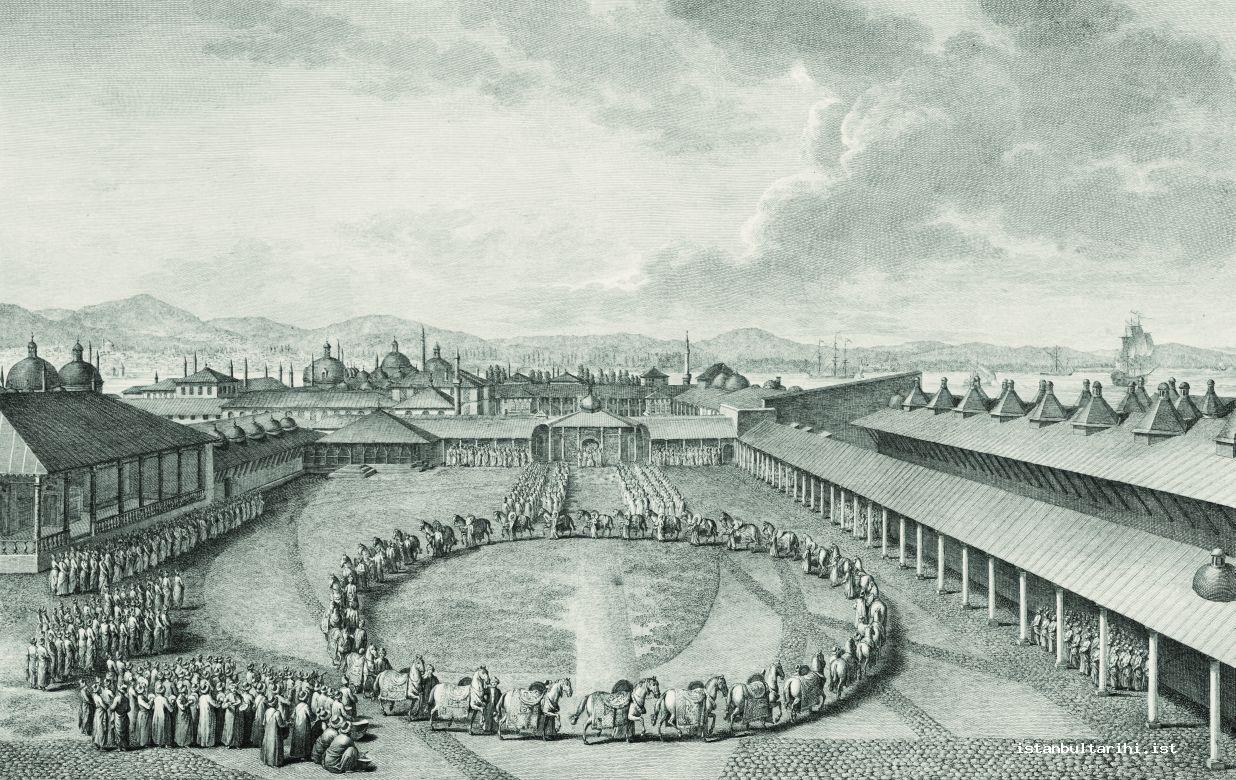
Upon the sighting of the crescent moon, a three-gun salute was given from two different points on the Historical Peninsula towards the Marmara coast and Galata; this would announce the start of Eid. On the day of Eid, after the morning prayer, cannons were fired from various points in Istanbul and from the gates of the palace, as well as in other cities.
The palace was illuminated with torches on the night of the Eid; the gates would open around midnight, and those who had been sent a tezkire would begin to arrive. Finally, shortly before the morning prayer, the sheikh al-Islam would arrive at the palace and go to the Old Divanhane. Immediately after him, the grand vizier would come to the palace and go to the Kubbealtı. He would rest in the Divit Odası until the morning prayer. Early in the morning, the hazinedarbaşı would take parts of the golden decorated throne from the inner treasury and set it up in front of the Bâbüssaâde.
The Eid greetings at the palace would commence in two different locations. Those in and around the Kubbealtı would congratulate the grand vizier on his Eid just after the morning prayer. The sultan would perform his morning prayers in the room of the Prophet’s mantle or in a masjid at the palace. After the prayer, the attendants in the Has Odası or Sarıkodası would dress the sultan in his ceremonial robes. Here, a greeting known as the muayede-i havass (the ceremony for the elite) would be performed, and the Darüssaade agha, silahdar agha, and other prominent palace aghas would congratulate the sultan on his Eid.
As the Eid greetings continued in two different locations, the attendants who were to be present at the main ceremony, known as the muayede-i umum (the public ceremony), would line up in a crescent shape across from the throne. The Zülüflü Baltacılar (woodcutters) and Crimean khans would create an array of bright colors with their ceremonial robes in the courtyard. The mehteran, an indispensable part of the muayede on military expeditions, was located in the square. The finery of the sultan’s horses would fascinate the visitors as extra horses would wait ready in the courtyard. Upon the news that the preparations had been completed, the sultan would sit on his throne in front of the Bâbüssaâde. The mehteran would start playing and would continue throughout the ceremony. Starting with the nakibüleşraf, everyone would congratulate the sultan on his Eid according to their place in the protocol. The ceremony would end with the protocol officer’s Eid greetings.
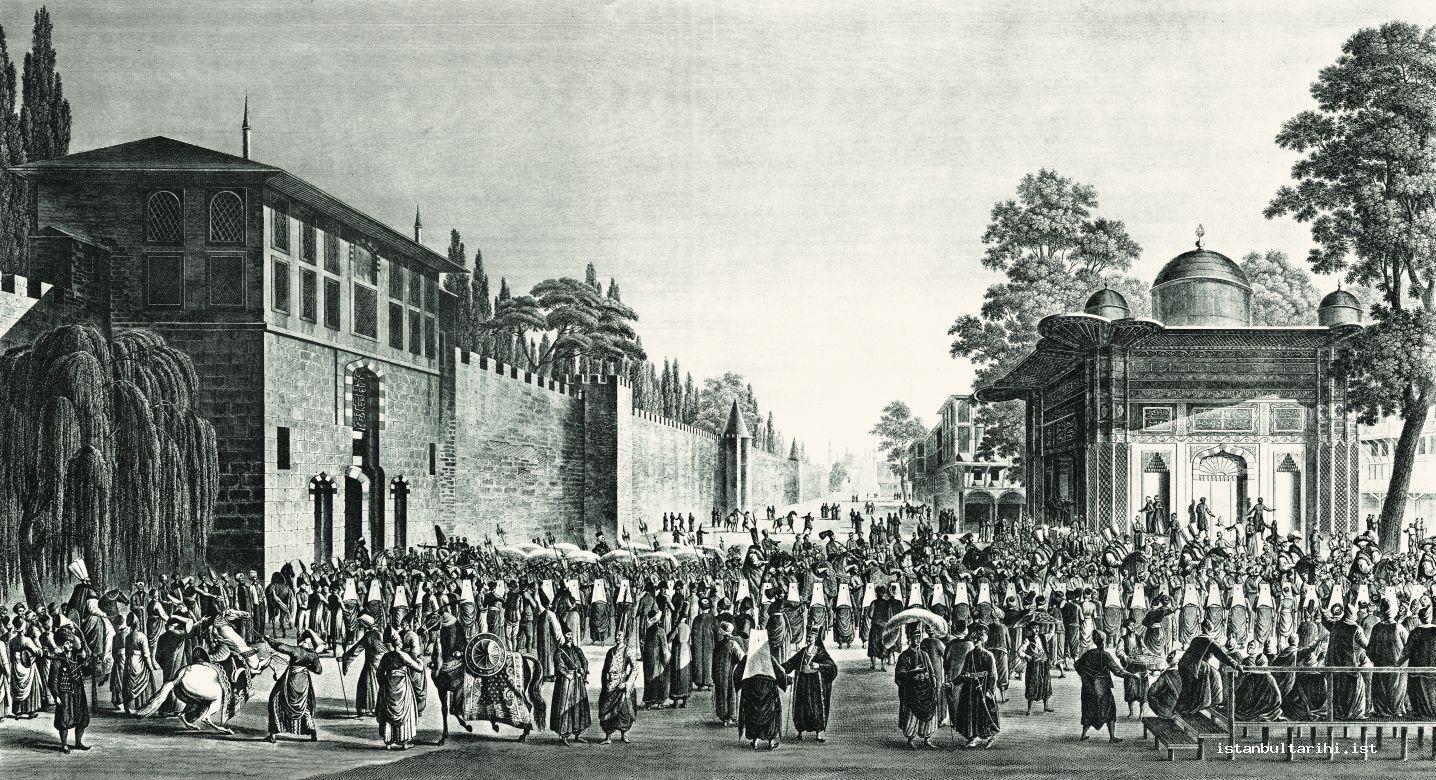
Once the ceremony was over, the sultan would go to the Has Odası to prepare for the festival procession. With the sultan’s departure on horse from the central gate, the procession would go towards the mosque where the morning prayers were to be performed. The sultan would generally choose the mosque himself; he would choose either Hagia Sophia or the Blue Mosque. The residents of Istanbul would take their places accordingly to watch the procession. After the morning prayer, the Janissary agha would make the Janissaries line up between the Bab-ı Hümayun and Ortakapı and wait for the procession to return. After the sultan left the mosque, he would return to the palace with the procession. Upon arriving at the palace, the sultan would sit on the throne that had been set up before the Has Odası and accept the Eid greetings of the Enderun community. In the harem, the harem community and princes would congratulate the sultan. Special Eid sweets, sent from the Matbah-ı Amire on gold and silver plates, were served to the state officials.
Following the meal, the sultan would go to Hasbahçe, one of the coastal palaces. Those skilled at cirit (javelin throwing), wrestling, rifle shooting, and archery would perform before the sultan; there would also be processions of artisan guilds. Sultans sometimes organized major festivals during the Eids. At these festivals, pavilions and marquees were erected in specific parts of the city for the sultan and state officials, and pavilions with lattice grills were constructed so that the women of the palace would be able to watch. The most interesting aspect of the festivities was the procession of the guilds who exhibited their talents in front of the sultan. The bakers would bake bread in portable ovens, the jugglers would perform acrobatics, the bookbinders would bind books; all of these would be presented to the sultan after this procession, known as ıydıyye.
In addition to the magnificent processions and festivities held by the palace, swings were another source of entertainment for the public during the Eids. They even attracted the attention of the foreigners in Istanbul. For example, according to Solomon Schweigger, who was in Istanbul between 1578 and 1581, scaffolds were set up on the sides of the streets, and ropes were tied to these to create a swing. Rugs covered the scaffolds to create a kind of canopy, and around it ornaments like citrus fruits, handkerchiefs, candy cones, and leafy branches were hung. People would go to the area where the swings were and swing with joy, flying up into the air. The officials who set up the swings would pull their customers high into the air using a cloth belt and would charge one akçe for five swings. According to what the author reports, some influential people would provide similar entertainments in their own homes and even the sultan would enjoy this kind of entertainment. Stringed instruments were played while people were swinging. Everyone, both young and old, would wear new clothes, or at least a new pair of shoes.17
The Venetian representative, Ottavio Bon, writes in his report about the reign of Ahmed I that the muayede-i umum performed in the palace early on the morning of Eid al-Fitr. He also details the procession to and from the Hagia Sophia Mosque, the banquet arranged in the Divan and the Second Courtyard, the gifts exchanged between the sultan and his people, and in particular, the various forms of entertainment. During the three days of the Eid celebration, the navy would carry out similar celebrations on the coast until morning; the sultan would meet with the women of the harem, and spend time with them, being more relaxed and casual than at other times. The sultan gave permission for round-the-clock entertainment and games in the city for three days. The entire country, the city of Istanbul, indeed, all Turkish homes would celebrate. The streets would be decorated; swings would be set up for both young and old. Two or three akçes were enough for a person to have a good time. But according to the Venetian representative, the Christians and Jews would encounter some difficulties on the streets during these days. During Eid al-Adha, the Turks celebrated day and night.18
At the request of the sultan, on the second day of the Eid, or a day later, the bayram rikabı resmi (official Eid reception) would be held at one of the palaces, such as Mehmet Paşa in Üsküdar, Gülhane, Davut Paşa, Dolmabahçe in Beşiktaş, Mehmed Paşa in Arnavutköy, Bebek, Göksu, or Florya. Towards the end of the eighteenth century, this ceremony started to be held on the second day of Eid in the Gülhane of either Dolmabahçe or Topkapı. The public could also watch the entertainment at Dolmabahçe. In the past, tents were set up in the Çubuklu Gardens of Tophane on the second day of Eid; banquets held by the grand vizier were attended by statesmen, for example, the sheikh al-Islam, nişancı, or defterdar. This ceremony would last until the evening.
On the third day of Eid, the streets of Istanbul would come alive again. On this day, the sultans would come to the Old Palace to exchange Eid greetings. There, they would watch the wrestlers, the cirit competition, the shows performed by silahşör aghas on horses, and the entertainment provided by the mehters. However, this tradition did not continue in the nineteenth century, as the sultans preferred to visit other resorts in the city instead.
Another ceremony that aroused excitement in the city was the grand vizier’s trip to Eyüp; here he would attend a banquet given by the Janissary agha on the third day of Eid al-Fitr. If it was winter, this banquet was held in a mansion at Aghakapısı or nearby in the walled city and entertainment would be provided. Following the banquet in Eyüp, the grand vizier would enter the city from Edirnekapı with a procession known as the büyük kol; this occurred immediately after the mid-afternoon prayers. If the grand vizier was not in Istanbul, the district governor took his place in the procession, and the sekbanbaşı would accompany the Janissary agha. This ceremony, which began in the second half of the seventeenth century, continued until the abolition of the Janissaries.
During the reign of Mahmud II, the muayede ceremonies were affected by Westernization policies, which had taken effect in the government and social life after 1826. The sultan eliminated the practices that were affiliated with the Janissaries. The rikab procession to Yalı Pavilion and similar places on the first day of Eid was officially abolished in 1826. The first exchange of the new-style Eid greetings was held in 1829 at Rami Çiftliği (Farm), where the Sultan had been for quite some time due to the Ottoman-Russian War. This ceremony underwent two major reforms: the sultan and state officials now attended in modern dress, with fezzes and uniforms, and the Muzıka-i Hümayun replaced the mehteran. They took part in the Eid procession from Rami to Eyüp Sultan Mosque. An exception to this was the Eid al-Adha muayede in 1830, which was held at Göksu Palace. In 1834 the muayede for the state officials was held after the ceremony in the palace, and some new guidelines regarding the ceremony were adopted. In 1839, the muayede ceremonies were postponed until after the morning prayer.
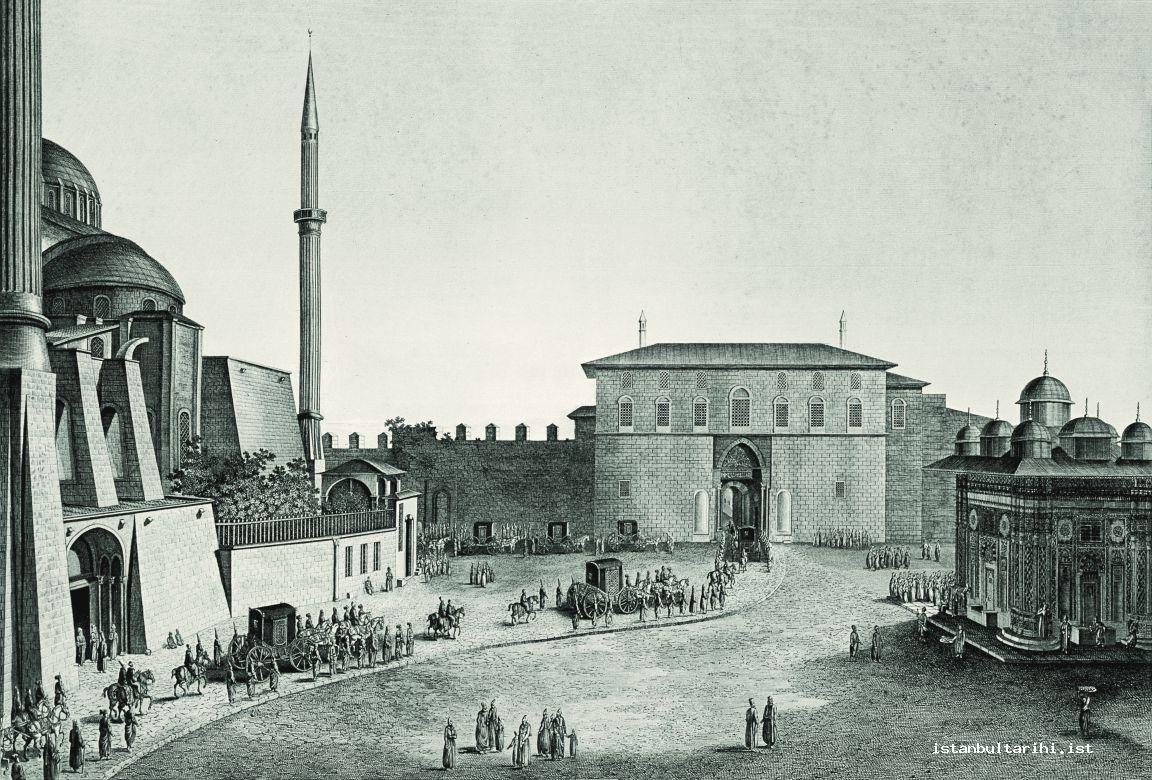
Despite the changes and the fact that Sultan Abdulmecid now resided in Dolmabahçe Palace, until 1867 the throne was still erected in front of the Bâbüssaâde in Topkapı Palace, and the ceremony continued to be held there. In 1867, during the reign of Sultan Abdulaziz, the official muayede began to be held in the ceremonial hall in Dolmabahçe Palace. Thus, the custom of the grand vizier heading for the Sublime Porte after the muayede in Topkapı Palace and exchanging Eid greetings there was abandoned; another regulation related to this issue was introduced the following year. Although the location of the muayedes changed, the sultans would travel to Topkapı Palace in a procession and go to Sultanahmet or Hagia Sophia, or more rarely to Fatih Mosque, for the Eid prayer, in keeping with tradition.
After some time, Abdulhamid II changed the route of the processions. Now the sultan, who resided at Yıldız Palace, would usually come to the Sinan Paşa Mosque in Beşiktaş in a procession, perform the morning prayers there, and then head to Dolmabahçe where the muayede ceremony would be held. Starting at midnight, the corps, who would be accompanied by a band, arrived in Beşiktaş with lanterns in their hands; they proceeded to line the streets between Yıldız Palace and Dolmabahçe Palace. The shops facing the streets would be closed on that day. After the Meşrutiyet Abdulhamid II had both of the muayede ceremonies held in Yıldız Palace for security reasons.
During the reign of Abdulhamid II, theatrical performances were part of the Eid festivals in Yıldız Palace. The wives of the ambassadors, representatives, and officials were brought to the palace in carriages, and following the banquet, they would watch theatrical performances with the women of the harem, later returning home in their carriages. Beginning on the eve of the Eid, twenty-one cannon-ball salutes were fired in Istanbul at the time of every prayer on Eid al-Fitr and Eid al-Adha. The city was adorned with lanterns, and the mansions of the sultans were illuminated at night. Lights that operated with the latest technology from Europe were brought to the city from time to time; these lights were a great source of entertainment for the residents. During the day, people would gather in public places in various districts, for example, within the city walls, or at Üsküdar, Galata, Kadıköy, Beyoğlu, Kasımpaşa, or Beşiktaş. Swings would be set up here as well, and sporting events like juggling, acrobatics, and various circus acts would take place in a large marquee.
During the reigns of Sultan Mehmed Reşad and Sultan Vahideddin, although the muayede processions were held in Dolmabahçe Palace, it was still customary to visit mosques other than those in Beşiktaş for the Eid prayers. However, the Eid ceremonies and processions had lost their former grandeur.
The Valide Alay
During the reign of Murad III, the harem was transferred from the Old Palace to Topkapı Palace. When a new sultan came to the throne, it was customary for the valide sultan (mother of the sultan), wives, and unmarried daughters of the deceased or dethroned ruler to go from Topkapı Palace to the Old Palace. The new valide sultan would be taken to Topkapı Palace from the Old Palace in a special ceremony known as the Valide Alay. If the new sultan and the former sultan had the same mother, this procession would not take place; in addition, if new sultan’s mother had died before his accession to the throne, or if the sultan was the son of one of the Haseki sultans (one of the concubines from the harem) then this procession would not take place. If the valide sultan had passed away before her son’s accession to the throne, the title would be given to the new sultan’s wet nurse, one of his stepmothers, or the hazinedar usta. However, there would be no valide alay.
Istanbul witnessed the first valide alay when Handan Sultan was brought from the Old Palace to Topkapı Palace by her son Ahmed I. In subsequent years, processions were held by Murad IV for Kösem Mahpeyker Sultan and Suleyman II for Saliha Dilâşûb Sultan. In the reign of Mustafa II, the procession for his mother Gülnuş Emetullah Sultan went from the Old Palace to Edirne; Mahmud I held a valide alay for Saliha Sultan, Osman III for Şehsuvar Sultan, and Selim III held a similar alay for Mihrişah Sultan. Mustafa IV held an alay for Ayşe Sîneperver Sultan and Mahmud II held one for Nakşidil Sultan. This ceremony came to an end during the reign of Mahmud II, after the Old Palace was abandoned as a place of residence.
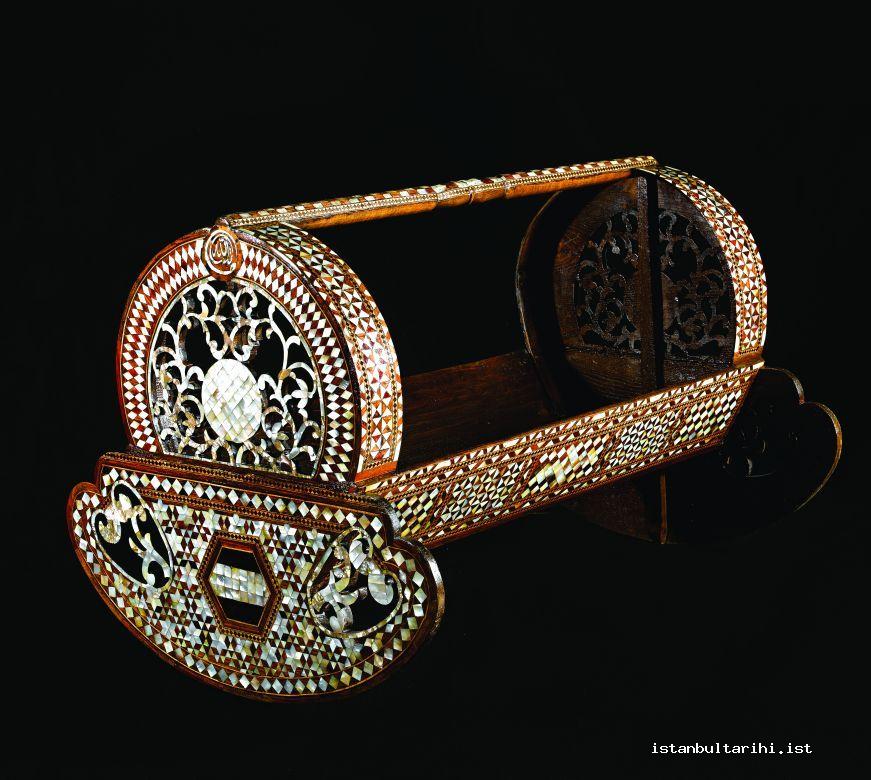
The valide alay would be held a few days after the sultan’s accession when the sultan gave orders for his mother to be transferred to Topkapı Palace. Invitations would be sent the day before the procession. The guests would arrive in front of the Old Palace dressed in their ceremonial robes, and the Janissaries would line both sides of the street, stretching from Beyazıt to Topkapı Palace. Once the preparations had been completed, the valide sultan would be brought in a carriage or palanquin, and the other female sultans and wives would be brought in other carriages, and the procession would make its way down the route. Selim III’s mother Mihrişah Valide Sultan was brought to Topkapı Palace on 11 April 1789 in a carriage covered by curtains and pulled by six horses; there were a total of eighty to one hundred carriages in the procession.
When the procession reached the Beyazıt Police Station, if the Janissary agha or the agha were on an expedition, their proxy, the sekbanbaşı, would salute the valide sultan by kissing the ground; he would be donned with a robe and given presents. The valide sultan would also give gifts to the aghas and the soldiers who were attending this ceremony. All along the route, the cebeci agha and the troops would salute the valide sultan from Parmakkapı, Destereciler Başı, and the police stations near the Valide Hamamı, as well as at the armorer stations near Acıhamam, Atmeydanı, and Hagia Sophia, at the Acemioğlanı Station on the other corner of Hagia Sophia, and in front of the Haseki Hamamı; she would give them presents. Finally, the cebecibaşı or his proxy and the troops who greeted the valide sultan in front of the Cebehane would also be given gifts. The people of Istanbul who had gathered on the streets to watch the procession would collect their share of the gold coins that were scattered by the handful.
The procession entered the palace from the Bab-ı Hümayun and stopped at the corner of the Hastalar Gate. No one could advance from this point; everyone would line up in two rows along the street. The valide sultan’s carriage would be greeted by the sultan in front of the Has Fırın (Imperial Ovens), and the sultan would salute his mother by bringing her hand first to his lips and then to his forehead. The sergeants would applaud, and the procession would disperse after the valide sultan entered the palace from the central gate.
A ceremony would be held in the Sublime Porte in which the sultan and his mother would send a hüküm (ruling), accompanied by a fur cloak and dagger, to the grand vizier or his deputies on the day after her arrival at the harem. If the grand vizier was on an expedition, a fur cloak was also sent for him while a similar cloak was sent to his deputy. In the second half of the eighteenth century, the valide sultans sent fur cloaks to the sheikh al-Islam as well.
The Imperial Births
The birth of the sultan’s children was known as the veladet-i hümayun (imperial birth). The arrival of a new member of the dynasty to the world was celebrated with a number of ceremonies and festivities, both in the palace and in the public.
During the first three centuries of the Ottoman Empire it can be seen that the sultans displayed their joy at becoming a father, either in the early capitals or in Istanbul, to society by making charitable donations and presents to society as a whole, and presenting a gift to the herald who brought the glad tidings. Neither Turkish nor foreign authors mention any celebrations or festivities held for such an event. In a sultanate in which the dynasty passed from father to son, laws of succession held sway. The birth of a son in particular meant the continuity of the dynasty for the sultan, and would pave way for the accession to the throne for the sultan’s son in a sanjak (province) and was thus a political event. However, there was no event in this period that brought the political nature of this occasion, at least from the perspective of the sultan, to the fore. This was due to the fact that, as far as the matter of appointing princes as a sancakbeyi in the organization, there was never a lack of children from the dynasties and harems that were to be found in different centers.
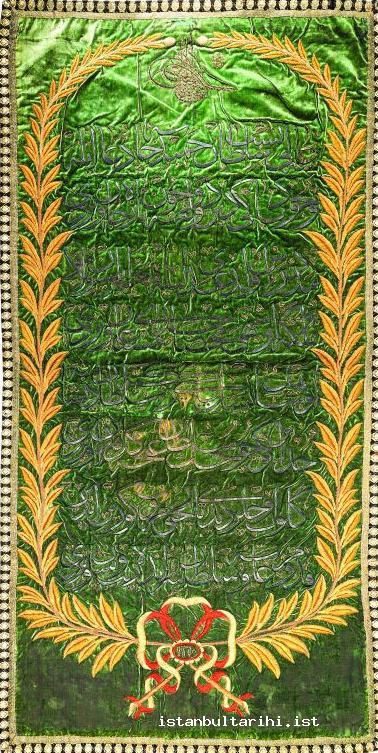
An event that occurred during the reign of Bayezid II is remarkable in that political meaning was given not to someone who was a member of the Ottoman dynasty, but merely a member of the family. Mirza Ahmed, Bayezid II’s son-in-law, had sought asylum in the Ottoman Empire due to the struggle for the throne between the Aq Qoyunlus; he then returned to Persia. The night after news arrived in Istanbul that he had ascended the throne in Tabriz, Mirza Ahmed’s wife, who was still in Istanbul, gave birth to a son. Bayezid II expressed his joy, saying, “Henceforth, the Persian province belongs to us,” lavishing gifts on the poor, and ordering that all the cities in the Ottoman state be decorated in celebration.19 This was also the first celebration of a birth held in Istanbul.
Beginning from the reign of Selim II, the eldest son would be sent to the provinces, and his harem traveled with him. There thus came to be two imperial harems rather than one. In the aftermath of this change, Murad III sent an edict, dated 24 Muharram 993/19 September 1585, to İbrahim Pasha, who had been assigned to improve Egypt’s situation, and another to the Yemen Guard, Hasan Pasha. He ordered that festivities be held “as usual” due to the births of his two sons.20 However, there is no information on whether this celebration, whose nature cannot be determined, was held in Istanbul.
In the reign of Mehmed III, with the abandonment of the practice of sending the eldest son to the provinces, the harem of the dynasty was again limited to only that of the sultan himself. Until the reign of Sultan Abdulaziz, the princes, with few exceptions, would establish their own harems and have children only after they came to the throne. While hunting in Rumeli Garden on 4 November 1604, Ahmed I, the first ruler of the new period, received news that his son had been born. His son was named Osman, after the founder of the dynasty, and Ahmed I ordered that his birth be celebrated by illuminating the city for seven days and seven nights. This is an example of how the birth of the sultans’ sons had an impact on the people. The birth of the sultan’s son had now become something that could affect the destiny of the dynasty and the state.
Following Ahmed I, the second imperial birth festivities were held by Murad IV. Upon the birth of his son in 1633, Sultan Murad had a candle illumination and fireworks festival organized in the Kandilli Garden, along the sea and the coast. Grander festivals were arranged in Istanbul, Galata, and Üsküdar in the following year for the birth of another son. For two years, no other child was born; the child of Sultan İbrahim was anxiously awaited, as he was the sole male member of the dynasty alive at the time of his enthronement. A much greater celebration was ordered for Şehzade Mehmed, who was born on 30 Ramadan 1051/2 January 1642; indeed, these were greater than any other celebrations that had been organized up until that time. The entire empire—not just Istanbul—was illuminated for a week.
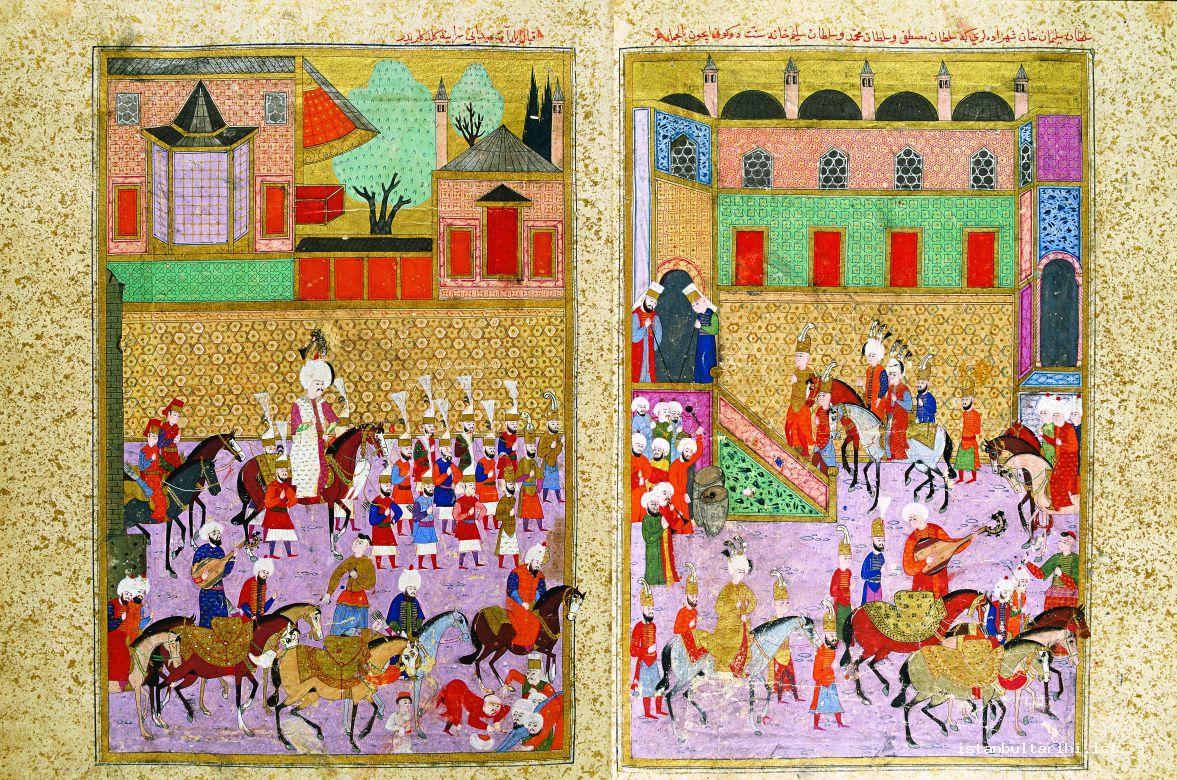
Although fathering girls and boys consecutively after Mehmed, Sultan İbrahim held the second celebration in the capital when another son was born in January 1645. Despite the bitter cold in Istanbul, a commemorative celebration was held during the day and a large illumination was arranged at night. Mehmed IV celebrated the birth of his first son Mustafa on 8 Dhu al-Qa’da/2 June 1664, in the Edirne Palace, arranging illuminations for seven days and seven nights in all cities of the empire. For the birth of his second son, Ahmed, on 22 Ramadan 1084/31 December 1673, Istanbul, Galata, and Eyüp were illuminated for three days and three nights.Mehmed IV’s successor Suleyman II did not have any children. Ahmed II, who succeeded him, arranged an illumination of four days and four nights for his twin sons who were born on 24 Muharram 1104/5 October 1692. When Mustafa II, who succeeded Ahmed II, received the news of the birth of his first son Mahmud, he was fighting on the Austrian front. As the enemy had not yet been defeated, he did not grant permission for a big celebration. Mustafa II, whose second son was stillborn, finally held an illumination of three days and three nights throughout the entire empire when his son Şehzade Mehmed was born on 18 Jumada al-Ula 1110/22 November 1698. No other festivities were held for the birth of his three other sons, who were born a few months apart, one after the other. For the birth of his son Selim on 27 Dhu al-Qa’da 1111/16 May 1700, the sultan wanted to have the entire capital illuminated. However, the statesmen objected; they claimed that the Christian ambassadors who were in the city in order to ratify the Treaty of Karlowitz (1699) would be inconvenienced; as a result there were only gun salutes were during the day and fireworks at night. Mustafa II celebrated the birth of his last son by having cannons and rifles fired from the palace square in Edirne. Ahmed III surpassed the sultans before him by having celebrations organized for the births of his six sons, although only up until 1722; he thus left his mark on the history of Istanbul.
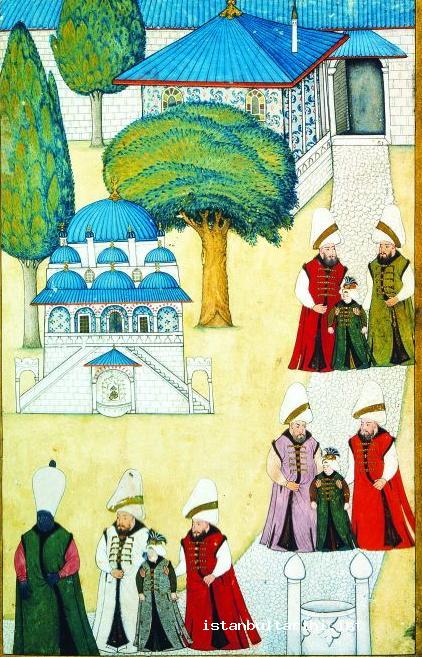
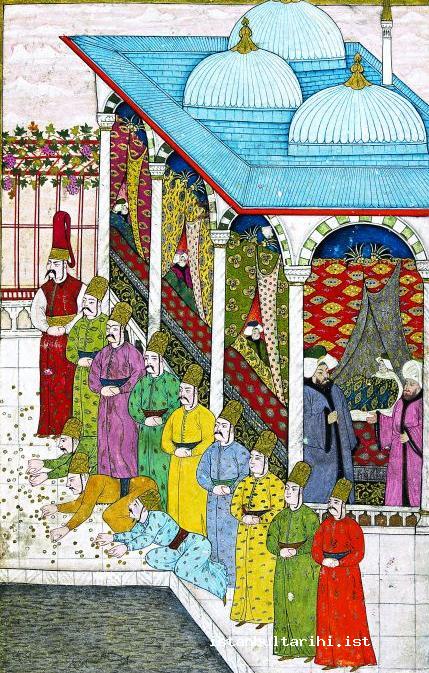
The public was concerned that there were no children in the harems of Mahmud I or Osman III. The news they had been waiting for came from Mustafa III’s harem in the second year of his reign. The excitement and joy the public felt upon hearing that the sultan’s wife was going to have a child is described vividly in the sources of the period. Preparations for the birth festivities began days before the birth, and these revivified the marketplace. The houses in the city were painted with paint purchased by the sultan. Mustafa III’s new daughter, Hibetullah Sultan, born on 15 Rajab 1172/14 March 1759, made history in the Ottoman State; until this time only the births of the sons had been celebrated by the palace and the public. However, the sultan ordered a seven day and seven night celebration and the festival was then extended to ten days due to public demand. The firework festival, which was to be held on the evening of the last day, was postponed due to the cold weather; it was held four days later on the sea across from the Yalı Pavilion.
After this, festivities continued to be arranged for the births of both the sons and daughters of the sultans. A festival that continued around the clock for seven days was held in Istanbul for the birth of Mustafa III’s first son Selim. The five day and five night illumination and commemorative celebration that was planned for the birth of Şah Sultan, born in the same year, was postponed to the second day of Eid al-Fitr. Although he considered adding five more nights to the festivals, the sultan curtailed the celebration due to another festival that had been scheduled in the Tersane. The births of Beyhan Sultan in 1765 and Hadice Sultan in 1768 were also celebrated.
Abdulhamid I initially followed in the footsteps of his predecessors. He had splendid festivals arranged in Istanbul for his three children, all born in the same year. The birth festival for Hadice Sultan in January 1776 lasted for ten days and nights; fireworks displays were held on the last three nights. For the births of Şehzade Mehmed in August and Şehzade Ahmed in December, illuminations were held for seven days around the clock. In the subsequent years, though, when Mustafa (b. 1779) and Mahmud (b. 1785) were born, the festivals were much less lavish due to negative political conditions and the sultan’s desire to reduce expenditures on things considered “extravagant.” Mustafa and Mahmud ascended the throne following Selim III. At the behest of Sultan Abdulhamid I, following an imperial birth, the needy, poor, and school children were given food in the court of the grand vizier, as well as in the mansions of statesmen and ministers.
Due to the short reign of Mustafa IV, and also due to the fact that Selim III did not have any offspring, celebrations were not held; they started to be held again in the reign of Mahmud II. Although the public officially celebrated the births of the sultan’s children in subsequent years, over time imperial births were no longer celebrated with festivals.
The traditional Ottoman palace festivals arranged for imperial births or other reasons are events that cast light on Istanbul’s political, economic, and social life. In these festivals, in particular the palace and the mansions of the state officials, as well as other places in Istanbul, would be adorned with colored glass lamps, candles, torches, and lanterns. Some places were decorated with precious fabrics, and in others places arches were constructed. Rather large model ships were made for some festivals, and cannon and rifles would be placed in them. These wheeled models were taken around the city, and they would fire their guns and rifles, thrilling the audience. Sometimes, models of ships at sea, a castle, or the islands were made and several performances would be staged around these.
In the city’s main squares, dancers, çengis, köçeks, orta oynucus, karagöz performers, singers and players, acrobats, fire-eaters, jugglers, strongmen, plate spinners, and many other performers would entertain the audience with their skills. Matrak, cirit, kabak, and azab competitions, as well as horse, dog, and archery competitions would be held. The procession of tekke and dergâh members as well as artisan guild members would last for days. Sugary treats in the shape of flowers, trees, or animals would be distributed; the gigantic nahıls (a wax statue, in the shape of a tree), which was a symbol of abundance and fertility, would be paraded through the streets even at the risk of destroying some houses. All these aspects were indispensable to the festivals and were particularly common at imperial weddings.
Additional security measures were taken so as to avoid disrupting the public order during the festivals. An extra duty that fell to the officials was repatriating the vagabonds who came to Istanbul from different parts of the empire for the festivals, but who did not leave, rather staying in front of shops or in bachelor hostels.At the time of the imperial births, in addition to official ceremonies, some customs and rules of protocol were applied. When the time for the birth approached, the valide sultan would provide the necessary items for the mother and child, and one of the rooms in the harem would be decorated with precious fabrics and jewels. The mother’s bedding and duvets would be red, a common color in the dynasty. In particular, much attention was paid to the decoration of the cradle; a Qur’an cover and a collection of talismans would be hung on the side of the bed. Once the baby was delivered safe and sound, the Darüssaade agha would give the news to the silahdar agha, who would announce the birth to the court. Then every room in the Enderun would sacrifice five sheep if it was a boy and three sheep if it was a girl. The corridors of the harem and the outside of the palace would be adorned with lanterns and oil lamps. To announce the good news, a palace attendant would come to the grand vizier. He would be greeted with a ceremony and would read aloud the imperial birth announcement. Meanwhile, the birth of the newest member of the dynasty would be publicly announced with the firing of guns in varying numbers, depending on the gender or the newborn’s order among its siblings, would be carried out at certain times from Topkapı Palace, Yedikule, the Maiden’s Tower, fortresses, and other places. The mehteran would start playing, and the town criers would go around the city.
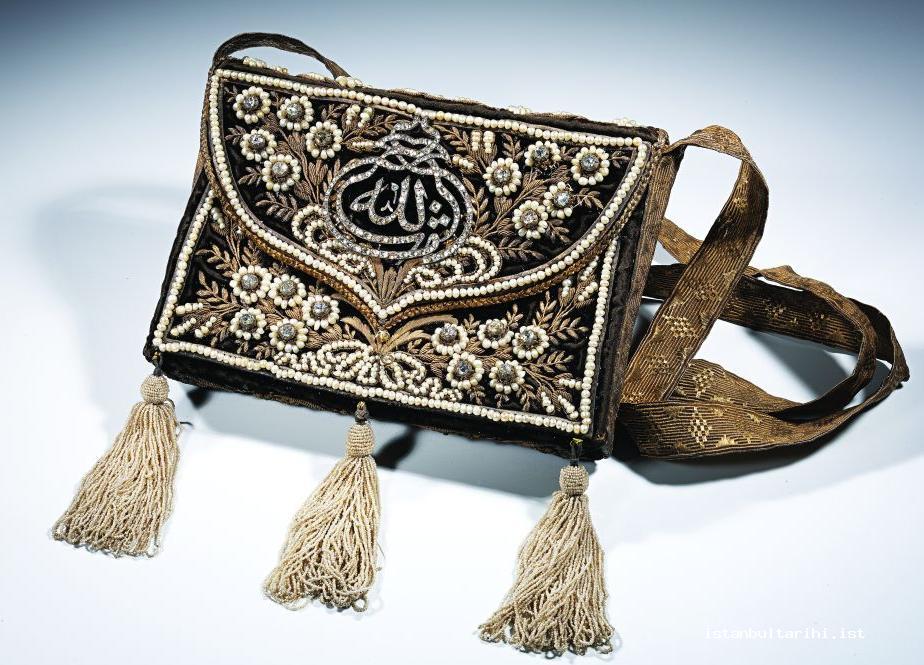
Having been informed of the birth and invited to the palace, the state officials would then go to meet the sultan on the following day, dressed in fur and robes, in order to congratulate him. In addition, the Darüssaade agha or the kahya kadın would announce the birth to the married sultans who lived outside the palace, the families of the leading statesmen, and the sheikh al-Islam via a letter, inviting them to the palace. The spouses of state officials would gather at the grand vizier’s mansion to go to the palace in carriages to see the new mother. The guests would be hosted at the palace for three days and they would attend the festivities that had been organized.
One of the customs practiced during the imperial births was the cradle procession. The valide sultan and the grand vizier would send gifts consisting of an adorned cradle and an embroidered quilt and duvet to the palace; these would go in separate processions. If the valide sultan was not alive, one of the women from the harem or a woman from the dynasty would undertake this task. The valide sultan’s cradle procession would set forth from the Old Palace immediately after the birth and go to Topkapı Palace by way of the Divanyolu. The grand vizier’s cradle procession, which was held six days after the birth and was larger than the valide sultan’s, would leave from Paşakapısı accompanied by the mehteran and go to the palace via the Divanyolu. The people of Istanbul would pour into the squares and roads, watching the procession while clapping and uttering prayers.
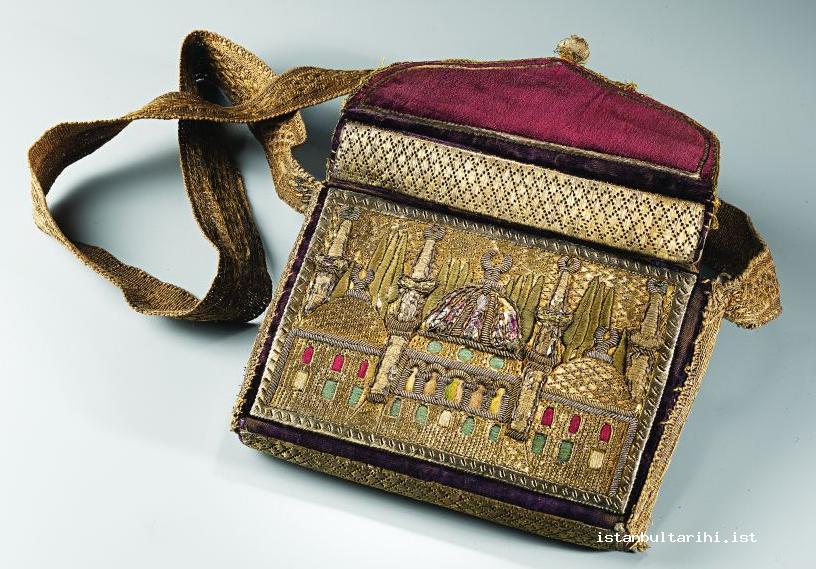
Circumcision Ceremonies
The circumcision ceremonies for the princes held a special place among Ottoman festivals and ceremonies. The circumcision ceremonies, known as sûr-ı hıtân, were the greatest festivals, projecting all the grandeur of the palace.
The first circumcision ceremony in Istanbul was held by Sultan Mehmed II in 1471 for his grandsons Abdullah and Şehinşah, who were born to his sons Şehzade Cem and Şehzade Beyazid. Şehzade Şehinşah was brought from Manisa and Şehzade Abdullah was brought from Trabzon. The sources record that the festivities held in the Old Palace lasted for days. A festival was organized again in the Old Palace in 1480 for the circumcision of Şehzade Cem’s son Oğuz Han, and Şehzade Bayezid’s sons Ahmed, Korkut, Mahmud, Alemşah, and Selim. Some of the şehzades were brought from their sanjaks and some were taken from their parents. The festivities lasted for a month.
Bayezid II, most of whose sons had been circumcised by his father, had a circumcision festival organized in the spring of 1490 for his son Şehzade Mehmed and his grandson Mehmed, the son of Şehzade Şehinşah. A tent was erected in the Old Palace from which the sultan could watch. The circumcision festival, which lasted for one month, enlivened the city of Istanbul with various entertainments and banquets.
Sultan Suleyman had two different circumcision feasts held in the Hippodrome. The first of these was the circumcision feast for Şehzade Selim, Şehzade Mehmed, and Şehzade Mustafa, held in 1530. A private mansion was built for the sultan in the Mehterhane in the Hippodrome and pavilions were constructed for the state officials. The festival, which commenced in late June with the arrival of the sultan and the members of the grand divan in the Hippodrome, entertained the people of Istanbul for three weeks, until mid-July. The second festival held by Sultan Suleyman was the circumcision feast for Şehzade Bayezid and Şehzade Cihangir, which lasted for a fortnight. It is said that this festival was not as extravagant as the first one in terms of entertainment or performances; however, it did not fall short in terms of food or drink.21
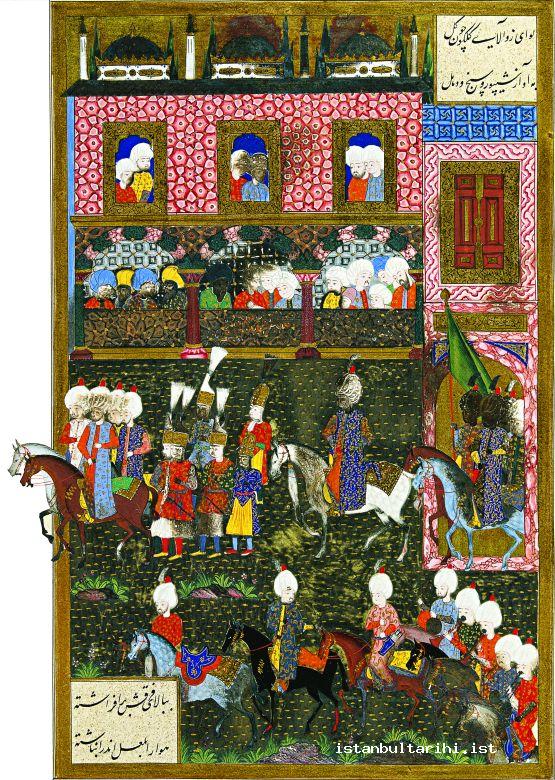
The circumcision feast that Murad III held for Şehzade Mehmed in the summer of 1582 was one of the grandest festivals witnessed in Istanbul. Preparations began a year in advance. The stairs to the entrance of the palace were renovated. Pavilions were built along the façade of İbrahim Paşa Palace, facing the Hippodrome, so that the sultan, şehzade, and people of the harem could watch the entertainment. Upon the completion of all the preparations, the festivities began; first the people from the harem, the şehzade, and the sultan took their places in the İbrahim Paşa Palace and the other guests took their places in the square. Although the festivities were supposed to last for a total of two months, due to a major row between the Janissaries and the cavalrymen, Murad III returned to his palace on the fifty-second day, thus bringing an end to the festivities.
When it became tradition to send only the older şehzades to the provinces, and particularly with the adoption of the ekber-erşed (seniority) system, the circumcision feasts diminished in number. Now four conditions had to be met in order to hold such a festival: the birth of a son, the son reaching the age of circumcision, the father still being on the throne, and the presence of appropriate social and political conditions. It was an exceptional coincidence if all of these conditions could be met, and thus circumcision festivities became rarer and fewer.
With Ahmed I’s accession to the throne, something was experienced for the first time: a month after his ascension to the throne, the new fourteen-year-old sultan was circumcised on 24 January 1604, in a ceremony accompanied by lavish festivals. Ahmed I’s son Murad IV and his grandson Mehmed IV were also circumcised in Topkapı Palace after their enthronement. Mehmed IV was circumcised with his three younger brothers and a one-week festival was held in the palace. Ali Ufkî notes that music played continuously for almost twelve days and nights in the presence of the sultan, while comedians performed several shows. After this, however, the sultan no longer enjoyed listening to music.22 Mehmed IV had an impressive festival held for the circumcision of his sons Mustafa and Ahmed in 1675, but chose Edirne as the location for the festivals.
The sûr-ı hıtân, which Ahmed III had organized for his princes Suleyman, Mustafa, Mehmed, and Bayezid in 1720 in Istanbul, was the largest festival in the eighteenth century. The festival started in Okmeydanı on 18 September and continued without pause for a fortnight. At the end, they returned to Topkapı, where the festivities continued day and night for six more days. Nahıls and sweets were prepared in the Old Palace and brought to Topkapı Palace in a grand procession on 9 October. On 10 October, the twenty-second day of the feast, the princes were circumcised in the palace in a ceremony attended by the statesmen.
The sultans, although desiring to hold grand circumcision ceremonies for their own children, did not have the same concern for the circumcision ceremonies of their sons of their heirs or their brothers. These princes were circumcised quietly in the palace. Indeed, during the reign of Ahmed III, Ahmed II’s son Şehzade İbrahim, who was kept in the şimşirlik (rooms for princes in the palace), and Mustafa II’s sons Mahmud, Osman, and Hasan were all circumcised secretly;23 the princes in the şimşirlik, while being a guarantee that the dynasty could continue, also posed a threat as an alternative to the ruling sultan.
Following Ahmed III, the people of Istanbul had to wait until the reign of Mahmud II for a new circumcision feast. Şehzade Abdülmecid and Şehzade Abdülaziz were circumcised in the last grand, traditional festival of the nineteenth century, held from 11 to 17 May 1836. Although Sultan Abdulmecid had his sons Mehmed Murad and Abdulhamid circumcised in 1847 and Mehmed Reşad had his sons Kemaleddin, Nureddin, and Burhaneddin circumcised in 1856 with twelve-day festivals, these festivities had lost their former grandeur and opulence. In addition, the location of the feasts had changed. Indeed, the circumcision feast in 1856 was held in the Maçka Barracks, on the land between Maçka Pangaltı and the Şişli Police Station. Circumcision festivities were held in 1870 by Sultan Abdulaziz for his son Yusuf İzzeddin Efendi; the feasts held by Abdulhamid II for the offspring of the dynasty did not have the same festive atmosphere.
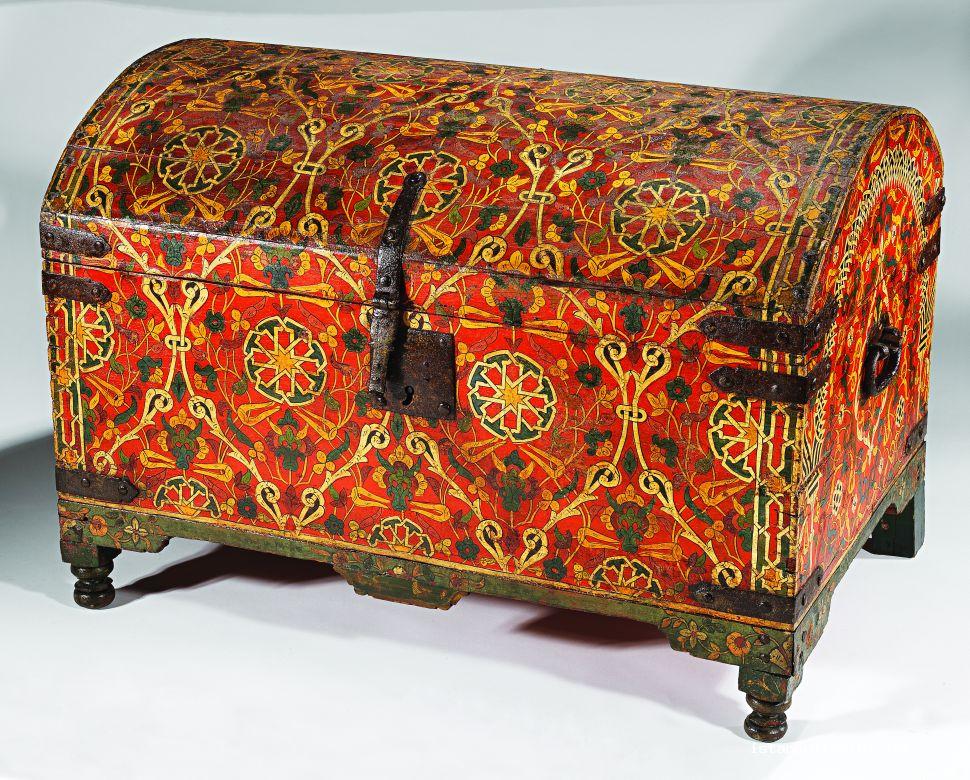
Sûr-ı hıtâns stand out as mass circumcision feasts that also featured entertainment, such as competitions, displays of talent, and guild processions. During the festivals, the içoğlans, zadegân children, including the poor in particular, and the sons of those living in and around Istanbul were circumcised, with all expenses being paid by the palace. According to İntizamî, in 1582 more than 10,000 boys were circumcised along with the princes; according to Mehmed Hafız, 3,285 were circumcised in 1720, while according to Vehbî’, 5,000 boys were circumcised at this time. In 1836, according to Hidr, 10,000 boys were circumcised, although according to Lebib this number was 5,046. Tahsin tells us that 8,000 boys were circumcised in 1847 and between 500 and 600 boys were circumcised in 1856. Abdulhamid II had mass circumcisions held both at the princes’ circumcision feasts and at other festivals.
The Bed’-i Besmele and Hatim Ceremonies of the Şehzades
The Ottoman princes would start receiving the theoretical part of their education in the palace. A ceremony called bed’-i besmele was arranged to mark the prince’s entry into education at the age of six; this ceremony was attended by statesmen.24 One of the leading scholars of the period would be appointed as tutor to the prince.
The bed’-i besmele ceremony was usually held at Topkapı Palace. However, sometimes this ceremony was held outside Istanbul. For example, Mehmed IV ordered his son’s bed’-i besmele to be held in Mora Yenişehir, Doğanköyü, where he was hunting in June 1669; the prince was brought here in a procession.25
The bed’-i besmele ceremony at Topkapı Palace was usually held in front of pavilions such as Alay Pavilion or Paşa Pavilion (İncili Pavilion), depending on the preference of the sultan. Before the day of the ceremony, tents would be erected for the statesmen in front of the pavilion. On the day of the ceremony, everyone would take his assigned place. A banquet would be given with coffee and dessert. The sultan would arrive at the pavilion after the feast at the palace. Upon greeting the sultan, the attendees would go to the central gate in a procession to bring the prince.
After a prayer was uttered in front of the Hırka-i Saadet Room, the Darüssaade agha would take the prince from the harem and put him on his horse. After the prince left through the central gate, the attendees would mount on their horses and go to the pavilion in a procession. The grand vizier would take the prince off the horse and carry him to the pavilion. The prince would kiss his father’s hand and sit beside him. Two cushions and a rahle were placed next to the sultan. At an auspicious time, which had been determined beforehand, the grand vizier would put the prince on his lap and sit him before the rahle. Everyone except the sultan would stand up and someone other than the sheikh al-Islam and the ulema would have the child recite Bismillah and all or a portion of the Arabic alphabet. Following this, the sheikh al-Islam and the sheikh from Hagia Sophia would utter a prayer and the palace muezzins outside would say “amen.”
The prince was then taken back to the palace in the same manner, and the procession would return to the area where the ceremony had been held. The sultan would dress the grand vizier, sheikh al-Islam, Darüssaade agha, naqib al-ashraf, and the first and second of the sultan’s imams in a fur robe. The grand vizier would offer gifts to the attendees and dress them in fur robes in the name of the sultan, thus bringing the ceremony to an end. During the bed’-i besmele, the prince was supposed to kiss the hand of the sheikh al-Islam, who helped him recite the alifba (the Arabic alphabet) for the first time; however, the sheikh al-Islam would not offer his hand and would instead kiss the şehzade’s shoulder as a show of respect to the heir. The grand vizier would give the prince gifts such as an alifba text, a Qur’an cover, and a hilal (special pointer to help children with reading) to mark the start of his training.
After the prince completed reciting the entire Qur’an, another ceremony would be held in the Hırka-i Saadet room. The ceremony, which the grand vizier and other viziers, the sheikh al-Islam, the Anatolian and Rumelia kadıaskers, the naqib al-ashraf, and the sheikhs of the Hagia Sophia and Valide Sultan mosques would attend, was held after the noon prayer. The reisülküttab, defterdar, and çavuşbaşı would watch the ceremony from the windows. During the ceremony, the prince’s tutor would be dressed in a fur robe for good luck, but others would not be. Finally, after various gifts were offered to the prince by the attending statesmen, the ceremony would come to an end. The Buhârî-i Şerîf ceremony would be held in the Hırka-i Saadet room in the same manner, and the statesmen and the sheikhs of the sultans’ mosques would generally gather in Hagia Sophia Mosque. The mehteran would accompany the procession on its way to and from Hagia Sophia.
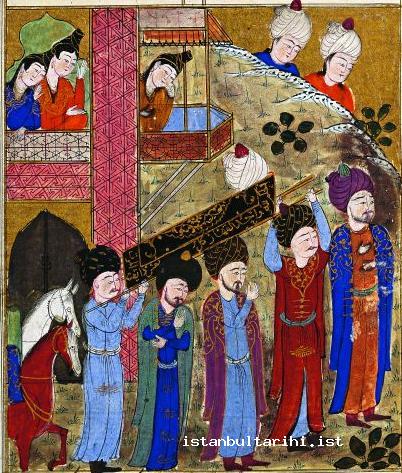
Towards the mid-nineteenth century, due to the Westernization process and the sultans leaving Topkapı Palace for other palaces, the bed’-i besmele ceremonies changed as well. When Şehzade Abdulmecid turned nine in 1832 and started his education, Mahmud II put on the greatest festival ever held in the Ottoman capital city. İbrahimağa Meadow in Haydarpaşa was selected as the location. The area was filled with tents stretching both towards Kadıköy and Üsküdar; thousands of people flocked from Istanbul to the Anatolian side by boat. It is reported that 150,000 people attended. The ceremony started when the sultan and the prince arrived at the festival location in two separate boats. Mahmud II sat on a throne that had been erected before the imperial pavilion. On his right were the sheikh al-Islam and the palace tutors, with the statesmen lined up on the sultan’s left. After kissing the edge of his father’s robe, Şehzade Abdulmecid received his first lesson on the divan that had been placed between the throne and the sheikh al-Islam. Twenty-four thousand troops participated in the parade that was part of this festival.
In subsequent years, the bed’-i besmele became a ceremony held privately in the palace rather than an official ceremony.
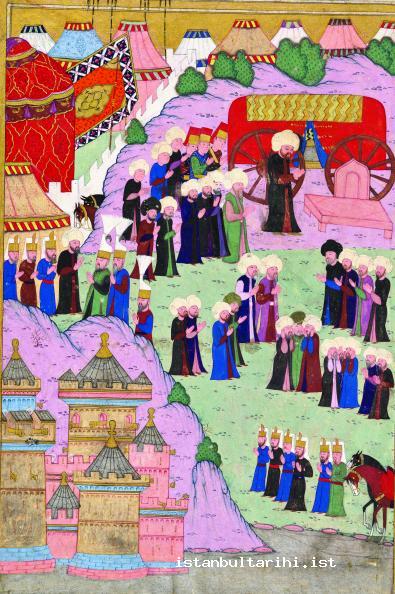
The Ceremony of Sending the Princes to the Provinces
Once they reached a certain age, Ottoman şehzades would be assigned to a sanjak (province) as a governor; an experienced statesman known as a lala would accompany them to help them learn about state administration. An official ceremony was held in Istanbul to mark this occasion.
After the rebellion of Prince Bayezid, the son of Suleyman the Magnificent, only the oldest son, that is the heir, would be posted to the sanjaks. Murad III’s son Şehzade Mehmet, appointed to Manisa, was the last to be sent as sanjakbey (governor). During the rule of Mehmed III, his oldest son was not posted to a sanjak. However, until the era of Mehmed IV, the şehzade was still assigned to a sanjak on paper, but a statesman, known as a mütesellim, would be sent in his place. Mehmed IV put an end to this practice.
The ceremony held to mark the posting of Murad III’s son Şehzade Mehmed to Manisa is the best example of such ceremonies that has been identified to date. Following his son’s circumcision, Murad III ordered that the preparations for sending him to the sanjak begin. Two thousand people were allocated as the şehzade’s retinue.
Şehzade Mehmed left the palace at dawn on a horse that had a gold-embroidered saddle. Some state officials gathered at the gates of the palace, but the Janissaries were not present. The prince was applauded as he left the Bab-ı Hümayun. Everyone started to walk, in order of protocol, in a procession towards the pier. First the şehzade’s lala Nevali Efendi walked out, followed by the grand vizier Siyavuş Pasha, and the other viziers, and finally the kadıaskers; keeping with tradition, they approached the şehzade and commented on the crowd and the army. As the şehzade entered the baştarda of the kaptan-ı derya, Kılıç Ali Pasha, who was waiting at the Vezir Pier. Cannons were fired and the statesmen, including the prince’s entourage and top viziers, boarded another baştarda.
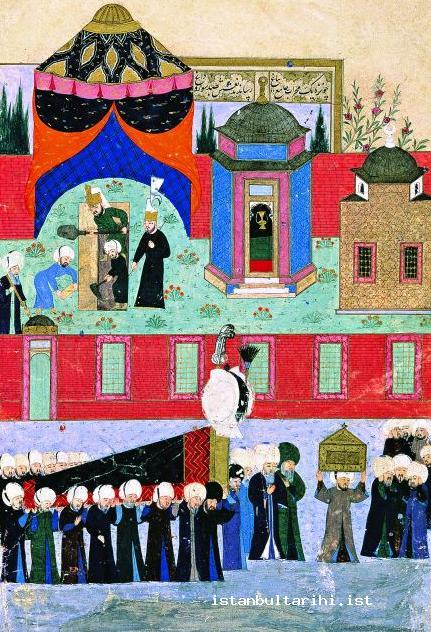
The prince disembarked at the state pavilion in Üsküdar with his retinue. Staying a few days more with the prince, the state officials would return to Istanbul after bidding him farewell.
The Weddings of the Sultanas
One of the royal ceremonies that enlivened the daily life of Istanbul was the marriage ceremonies of the daughters of the dynasty.
When the sultan wanted one of his daughters to marry, he would let the grand vizier know his choice for the groom; he made this decision after taking into consideration the grand vizier’s advice. When the groom had been selected, an edict would be written to him about sending engagement gowns. Thereupon, feverish preparations would begin both in the palace and on the groom’s side. Acting as the head of the dynasty, the sultan was obliged to provide all the requirements for the bride, whether she was his daughter or not. He would have a palace built in the city for the newlyweds and would rent a suitable mansion, with the condition that the rent be paid from the treasury.
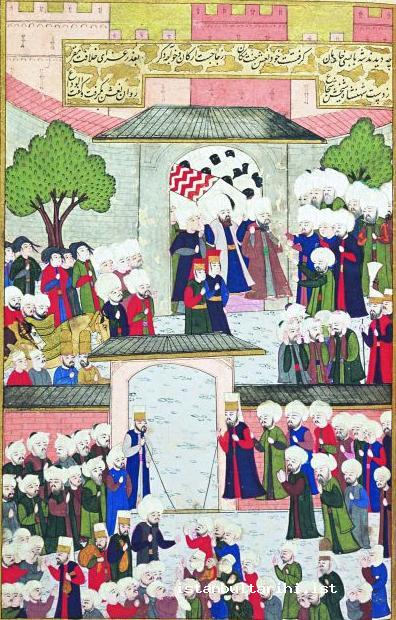
The main dowry that the groom would send to the palace consisted of mihr-i müeccel (dowry), rings, a belt, a pair of earrings and bracelets, mirrors, pearls, jeweled shoes, mest (light and thin-soled shoes), and nalın (bath clogs). The value of the dowry could increase, depending on the groom’s wealth. In addition, it was customary for the groom to present gifts to others, in particular to the valide sultan and members of the harem. If the groom’s financial situation was poor, he would be assisted with money from the treasury in order to complete the preparations.
The engagement and marriage ceremonies were held on different days; invitations were sent to the guests indicating the time they should arrive at the palace. Until the end of the sixteenth century, some wedding ceremonies were held in the Old Palace due to the fact that the women of the dynasty lived there. When the harem had moved completely to Topkapı Palace, the weddings of the sultans’ daughters were held there, and the weddings of the daughters of the sultan’s predecessors were held in the Old Palace. In the nineteenth century, weddings were held in other palaces, for example Çırağan Palace, Dolmabahçe Palace, or Yıldız Palace. While the Darüssaade agha had previously been in charge of planning the wedding, in the Tanzimat Period this task was undertaken by the baş-mabeynci.
During the period when Topkapı Palace was used, the ceremonial area of the palace was decorated on the date of the wedding and pavilions were set up for the guests. The groom’s engagement package was submitted by the Darüssaade agha at the gate of the harem. Taking these inside, the agha would submit the bride’s engagement presents to the best man. Upon the acceptance of the bundle and a scarf with an embroidered edge, the engagement was official and a banquet was provided for the guests. The next day the marriage of the couple was solemnized. According to how favored the father of the bride was, or if he was a disliked predecessor or for other reasons, the wedding ceremony could be held in the Kubbealtı, Darüssaade, the agha’s room, or in another part of the palace. After the attendees settled in the portion of the room that had been prepared for them, the Darüssaade agha would stand in for the bride and others would stand in for the groom and the witnesses; the sheikh al-Islam would then make the marriage contract. After the Darüssaade agha notified the sultan of this, the attendees were dressed in ceremonial kaftans and treats were served, marking the end of the ceremony.
The groom would hold a banquet at his mansion for the statesmen, based on their ranks. At this time, the palace was experiencing the excitement of the bride’s henna night. Who attended the henna night from the wives of the statesmen and the value and the amount of the gifts they brought were recorded in a book by the grand vizier; this was presented to the sultan. The guests and members of the harem would entertain themselves until late at night, when they would retire to the rooms of the sultan’s kadın efendis, who would host them for the night.
After the henna night, the dowry would be taken to the groom’s mansion in a grand procession. On the following day, the bride would be taken to the groom’s mansion in a red carriage in a procession more grand than the previous one, and would appear before the guests in her own harem in a red bridal gown. The people of Istanbul would flock to streets to see this procession. The dowry procession was generally held on a Wednesday, while the bridal procession, also known as arus alayı, was held on a Thursday; sometimes both processions were held on the same day. This remained the same until the end of the Ottoman State. However, Abdulhamid II’s daughter Naime Sultan wore a white bridal gown instead of a red one at her wedding to Kemaleddin Pasha in 1898; after this the sultanas chose their own bridal gowns.
Among those who accompanied the bride, only the grand vizier, sheikh al-Islam, and viziers could wait in the groom’s mansion until the night prayer. After the prayer and the sheikh al-Islam’s prayers, the groom was sent to the harem and the others would go back to their own mansions. The next day, the groom and the sultana would send gifts to the state officials. Those who received presents would tip the people who had delivered them and give them presents. In this way, the wedding ceremony came to an end.
The length and luxury of the sultanas’ weddings would depend on the sultana who was getting married. For example, the wedding of the daughter of a predecessor, liked or disliked, could be completed in one or two days in an unremarkable manner. In contrast, the first or most beloved daughter’s wedding would be a highly pompous event. Sometimes Istanbul would celebrate both a circumcision and a wedding at the same festival. For example, the grandson of Sultan Mehmed II, Şehzade Abdullah, married one of the sultan’s granddaughters, the daughter of Şehzade Mustafa, at the circumcision feast in 1480. Bayezid II married his three daughters to Uzun Hasan›s grandson Mirza Ahmed, Veziriazam Davud Pasha’s son, and Nasuh Bey’s son in a festival in 1490. Suleyman the Magnificent had a celebration for the marriage of his daughter Mihrimah Sultan to Rüstem Pasha in 1539.
For many years, the Hippodrome was the main location for weddings as well as for other festivals; however, from the early eighteenth century on, particularly in the nineteenth century, significant changes were made to both the arrangement of these festivals and the location. In 1562, the weddings of Selim II’s daughter İsmihan Sultan to the grand vizier Sokullu Mehmed Pasha, Şah Sultan to Çakırcıbaşı Hasan Agha, Gevherhan Sultan to the kaptan-ı derya Piyale Pasha, and in 1648 the wedding of Sultan İbrahim’s daughter Atike Sultan to Kenan Pasha all took place in the Hippodrome.
The imperial weddings in the era of Ahmed III have an important place in Istanbul’s history. The sultan arranged legendary weddings for his daughters in 1708, 1709, and 1710 and for the daughters of his brother Mustafa II in 1724. Festivities that lasted for a fortnight were arranged in Istanbul for two weddings in 1709 and 1710. The weddings of Mustafa II’s daughter Ayşe Sultan to Tezkereci İbrahim Pasha and his other daughter Emetullah Sultan to Osman Pasha also took place during the circumcision feast in 1720.
The wedding of Mahmud II’s daughter Saliha Sultan to Halil Rifat Pasha in 1834 was the first great imperial wedding of the nineteenth century. The wedding of Mihrimah Sultan and Mehmed Said Pasha in 1836 was even more pompous. Istanbul was decorated with candles, mahyas, and torches from top to bottom. The wedding of Sultan Abdulmecid’s daughter Fatma Sultan to Ali Galip Pasha in 1854, Cemile Sultan’s wedding to Mahmud Celaleddin Pasha, and Münire Sultan’s wedding to İbrahim Hilmi Pasha in 1858 were other splendid weddings of this period.
Funeral Ceremonies
Beginning from the reign of Sultan Mehmed II, all the Ottoman rulers, except for Sultan Vahideddin, were buried in Istanbul.
During the periods when the şehzades were posted to the sanjcaks in Anatolia but before the succession law had been fully systematized, the news of the death of one of the sultans was kept secret until one of the princes had come to Istanbul and ascended the throne as the sultan. The body of the deceased sultan was embalmed or preserved in a cold place. After a sultan died, the laws were deemed invalid until another sultan had ascended the throne. Thus, the troops could plunder the city and everything would be in a state of chaos. Everything that happened during this process would develop depending on the administrative ability of the statesmen. Messages were sent requesting the urgent return of each prince to Istanbul. After the new sultan ascended the throne, he would order the funeral ceremony of his father to be carried out.
After the adoption of the ekber-erşed system, the bodies of the deceased sultans were no longer kept waiting and the chaos that could have overtaken Istanbul was avoided. In this new period, once a sultan had passed away, the Darüssaade agha would immediately inform the grand vizier. Without delay, the grand vizier would gather the statesmen at his mansion and then take them to the Sublime Porte; following this he would go to the palace. After performing the ceremony of enthronement, the new sultan would order the predecessor’s funeral rites to be performed. After the assassination of Sultan İbrahim, it became law that the death of the sultan needed to be investigated to determine whether the ruler had been assassinated or not. Therefore, the body would be examined with the clothing on, and if nothing was discovered, the body would be washed. For example, during the reign of Mustafa II, the body of Şehzade İbrahim, who passed away at the early age of twenty-two, was examined by statesmen, the ulema, and kolağas in order to avoid rumors.26
After the sultan’s body had been washed and wrapped, it would generally be put in a coffin set on a piece of marble in front of the Hırka-i Saadet room, and the Darüssaade agha would stand next to it. It was customary for the coffin to be made from walnut. When Süleyman the Magnificent passed away near Zigetvar, Sokullu Mehmet Pasha learned that the throne in Ösek Castle had been made of walnut; he asked for it to be used as the minbar in a mosque that was to be built, had it brought to Zigetvar, and used it to build a coffin for the sultan.27
With the permission of the new sultan, the coffin would be put on a tahtabent prepared in locations such as Topkapı Palace, Helvahane Önü, or Bâbüssaâde Önü, and the funeral prayer would be performed here. For sultans who passed away outside of Istanbul, although the prayer was carried out at the location where the sultan died, it was performed again at the palace. It was the law that the sheikh al-Islam lead the prayer. If he was unavailable for a legitimate reason, the Rumelia kadıasker or prominent figures such as the hünkâr imam or another member of the ulema would lead the sultan’s funeral prayer. There were exceptions to this. For example, the funeral prayer of Mehmed II was led by Sheikh Ebülvefa, one of the famous Sufis of the period. Statesmen in Istanbul were required to attend the prayer, and the new sultan would participate in it from the Arz Odası or in front of the Has Odası.
The news of the death of the sultan or another member of the dynasty was announced to the people of Istanbul via the call to prayer from the sultan’s mosques, such as Hagia Sophia, Sultanahmet, Süleymaniye, or Fatih. Also, the town criers would go around the city to announce both the death and the new sultan by crying: “It is .........’s reign.” Unless informed of the death by the Darüssaade agha, the grand vizier would not decree that sala be recited in the mosques. The heir would decide where the deceased sultan would be buried. When the burial place was certain, the statesmen, after carrying it from the central gate on their shoulders, would transfer the coffin to the teberdars. A cortège would immediately be arranged. The corpse would be put in a carriage and transferred to the burial place. Of the palace aghas, only the Darüssaade agha could attend the funeral cortège. The people of Istanbul would join the funeral cortège after the corpse had left the palace.
One of the interesting customs in the sultan’s funerals was the mourning. The attendees, including the new sultan, would wear dark clothing and a black turban, or wrap a shamla (a black veil made of hair) on their turbans, as a sign of mourning. The official mourning would last from three to seven days and end on the orders of the new sultan. This mourning rite was abolished in the mid-seventeenth century. Mourning was not limited to the palace, but would reverberate around the city. For example, while the corpse of Sultan Mehmed II was being taken to his tomb, horses with trimmed tails and high saddles were waiting in front of the funeral cortège. The turban and archer’s bow (broken) belonging to the deceased sultan were put on the coffin. After the completion of the burial, the turban and sword of the sultan were placed in his grave.28
The funerals of the deceased sultanas were always conducted in Topkapı Palace with an official ceremony. The corpse would be taken to the burial place with a cortège by carriage on land or by boat if by sea. The corpses of the deceased sultanas who passed away in their palaces or in the Old Palace would be brought to Topkapı Palace. The funeral prayers of the sultanas were performed either in the palace or at the burial palace, in contrast to the funeral prayers for the males of the dynasty. After being notified of the death by the tezkires, the statesmen would attend the funeral dressed in formal gowns. Funerals would be held both for the sultans’ wives and for the valide sultans. As the deceased offspring of the sultanas were not considered to be part of the dynasty, they were buried without an official ceremony.
BIBLIOGRAPHY
III. Selim’in Sırkâtibi Ahmed Efendi Tarafından Tutulan Rûznâme, prepared by V. Sema Arıkan, Ankara: Türk Tarih Kurumu, 1993.
Ahıshalı, Recep, “Divân-ı Hümâyun Teşkilâtı”, Osmanlı, ed. Güler Eren, Ankara: Yeni Türkiye Yayınları, 1999, vol. 6, pp. 24-33.
Akbayar, Nuri and Nejdet Sakaoğlu, Binbir Gün Binbir Gece: Osmanlı’dan Günümüze İstanbul’da Eğlence Yaşamı, Istanbul: Creative Yayıncılık, 1999.
Alikılıç, Dündar, Osmanlı Devlet Protokolü ve Törenler: İmparatorluk Seremonisi, Istanbul: Tarih Düşünce Kitapları, 2004.
Ali Seydi Bey, Teşrifât ve Teşkilât-ı Kadîmemiz, prepared by Niyazi Ahmet Banoğlu, Istanbul: Tercüman Gazetesi, n.d.
And, Metin, “16. Yüzyılda Elçilikler ve Elçiler”, Hayat Tarih mecmuası, 1970, vol. 1, no. 3, pp. 20-25.
And, Metin, 16. Yüzyılda İstanbul, Kent, Saray, Günlük Yaşam, Istanbul: Akbank Yayınları, 1993.
And, Metin, Kırk Gün Kırk Gece, Osmanlı Düğünleri, Şenlikleri, Geçit Alayları, Istanbul: Toprakbank/ Creative Yayıncılık, 2000.
Arslan, Mehmet, Osmanlı Saray Düğünleri ve Şenlikleri, VIII vol., Istanbul: Sarayburnu Kitaplığı, 2008-2011.
Atalar, M. Münir, Osmanlı Devleti’nde Surre-i Hümâyun ve Surre Alayları, Ankara: Diyanet İşleri Başkanlığı, 1991.
Atasoy, Nurhan, “Hırka-i Saâdet”, DİA, XVII, 374-377.
Atasoy, Nurhan, 1582 Surnâme-i Hümâyun: Düğün Kitabı, Istanbul: Koçbank, 1997.
Atıl, Esin, Levnî ve Surnâme: Bir Osmanlı Şenliğinin Öyküsü, Istanbul: Koçbank, 1999.
Bozkurt, Nebi, Doğan Yavaş, “Mukaddes Emanetler Dairesi”, DİA, XXXI, 111-14.
Dersaadet’ten Haremeyn’e Surre-i Hümayun, prepared by Yusuf Çağlar and Salih Gülen, Istanbul: Yitik Hazine Yayınları, 2008.
Ertuğ, Zeynep Tarım, “18. yüzyıl Osmanlı Sarayında Bayram Törenleri”, Prof. Dr. Mübahat Kütükoğlu’na Armağan, ed. Zeynep Tarım-Ertuğ, Istanbul: İstanbul Üniversitesi Edebiyat Fakültesi, 2006, pp. 582-594.
Ertuğ, Zeynep Tarım, “Osmanlı Devlet Teşrifatında Hırka-i Şerif Ziyareti”, TED, 1998, no. 16, pp. 37-45.
Ertuğ, Zeynep Tarım, “Osmanlı Devletinde Resmî Törenler ve Birkaç Örnek”, Osmanlı, edited by Güler Eren, Ankara: Yeni türkiye Yayınları, 1999, vol. 9, pp. 133-142.
Esad Efendi, Osmanlılarda Töre ve Törenler (Teşrifât-ı Kadîme), prepared by Yavuz Ercan, Istanbul: Tercüman Gazetesi, 1979.
Faroqhi, Suraiya, Hacılar ve Sultanlar (1517-1638), translated by Gül Çağalı Güven, Istanbul: Tarih Vakfı Yurt Yayınları, 1995.
Göktaş, Uğur, “Mahyacılık”, DBİA, V, 275.
İpşirli, Mehmet, “Elçi”, DİA, XI, 3-15.
“Kadir Alayı”, DBİst.A, IV, 369.
Karaca, Filiz, “Tanzimat Dönemi ve Sonrasında Osmanlı Teşrifat Müessesi”, Phd thesis, Istanbul University, 1997.
Karateke, Hakan T., An Ottoman Protocol Register, Containing Ceremonies from 1736 to 1808: BEO Sadaret Defterleri 350 in the Prime Ministry Ottoman State Archives, Istanbul, London: The Royal Asiatic Society, 2007.
Kazıcı, Ziya, “Alay Köşkü”, DİA, II, 346-350.
Kuban, Doğan, “Yalı Köşkü”, DBİst.A, VII, 416-417.
Levend, Âgah Sırrı, Nabî’nin Surnâmesi, Istanbul: İnkılap Kitabevi, 1944.
Mercan, Halil, “Teşrîfâtîzâde Mehmed Efendi’nin Defter-i Teşrîfâtı (Transkripsiyonu ve Değerlendirmesi)”, post graduate thesis, Erciyes University, 1996.
“Mevlit Alayı”, DBİst.A, V, 431.
Mumcu, Ahmet, “Divân-ı Hümâyûn”, DİA, IX, 430-432.
Nutku, Özdemir, “Bayram Alayı”, DİA, V, 265-266.
Nutku, Özdemir, “Bayram”, DİA, V, 263-265.
Nutku, Özdemir, IV. Mehmet’in Edirne Şenliği (1675), Ankara: Türk Tarih Kurumu, 1987.
Nutku, Özdemir, Tarihimizden Kültür Manzaraları, Istanbul: Kabalcı Yayınevi, 1995.
Orgun, Zarif, “Osmanlı İmparatorluğunda Nâme ve Hediye Getiren Elçilere Yapılan Merasim”, TV, 1941, vol. 1, pp. 245-253.
Ortaylı, İlber, “Baklava Alayı”, DBİst.A, II, 5.
Öcal, Mustafa, “Âmin Alayı”, DİA, III, 63.
Önal, Ahmet, “18. Yüzyıla Ait Buyuruldu Mecmuası (Türk Tarih Kurumu Y.70-Değerlendirme-Transkripsiyon)”, post graduate thesis, Marmara University, 2006.
Sakaoğlu, Necdet, “Bayram Alayı”, DBİA, II, 99-101.
Sakaoğlu, Necdet, “Hırka-i Saadet Ziyareti”, DBİst.A, IV, 67-68.
Sakaoğlu, Necdet, “Surre Alayı”, DBİst.A, VII, 80-81.
Sarıcaoğlu, Fikret, “Dîvân-ı Hümâyunun Kronolojik Toplanma ve Merasim Günleri”, Osm. Ar., 2008, no. 30, pp. 87-143.
Sinanlar, Seza, Atmeydanı, Bizans Araba Yarışlarından Osmanlı Şenliklerine, Istanbul: Kitap Yayınevi,2005.
Şahin, H. Hümeyra, “Bâbıâli’de Uygulanan Teşrifat (1703-1839)”, post graduate thesis, Marmara University, 2001.
Şeker, Mehmet, “Mevlid”, DİA, XXIX, 479.
Uluçay, Çağatay, “İstanbul’da XVIII ve XIX. Asırlarda Sultanların Doğumlarında Yapılan Törenler ve Şenliklere Dair”, İstanbul Enstitüsü Mecmuası, 1958, vol. 4, pp. 199-213.
Uluçay, Çağatay, Harem II, Ankara: Türk Tarih Kurumu, 1992.
Uluçay, Çağatay, Padişahların Kadınları ve Kızları, Ankara: Türk Tarih Kurumu, 2001.
Uzunçarşılı, İsmail Hakkı, “1224 (1809) Senesinde Rus Seferine Gidecek Olan Kapıkulu Ocaklarının İstanbul’dan Hareketleri Esnasında Teşrifat Mucibince Yapılan Merasim”, TTK Belleten, 1943, vol. 7, no. 25, pp. 101-111.
Yıldırım, Üzeyir, “Osmanlılar’da Cülus ve Buna Dair Bir Kaynak Eser”, post graduate thesis, Mimar Sinan University, 2007.
Ziroviç, Olga, “Yabancı Elçilerin Osmanlı Memleketlerinde Seyahatleri ve Huzura Kabulleri”, BTTD, 1968, vol. 4, pp. 45-53.
FOOTNOTES
1 For a description and the different manners in which the sultan would mount a horse, board a boat, etc., see: Fikret Sarıcaoğlu, Kendi Kaleminden Bir Padişahın Portresi: Sultan I. Abdülhamid (1774-1789), Istanbul: Tarih ve Tabiat Vakfı Yayınları, 2001, pp. 41-42, 44, 47.
2 Fâtih Sultan Mehmed, Kānûnnâme-i Âl-i Osman, ed. Abdülkadir Özcan, Istanbul: Kitabevi, 2003, p. 16.
3 Mehmet Ali Beyhan, Saray Günlüğü 1802-1809, Istanbul: Doğu Kütüphanesi, 2007, pp. 16-17.
4 Abdülkadir Özcan, “Biniş”, DİA, VI, 184-185.
5 Luigi Bassano, Kanunî Dönemi Osmanlı İmparatorluğu’nda Gündelik Hayat, tr. Selma Cangi, Istanbul: Yeditepe Yayınevi, 2011, pp. 67-68.
6 Sarıcaoğlu, Sultan I. Abdülhamid, pp. 41-53.
7 Bassano, Osmanlı İmparatorluğu’nda Gündelik Hayat, p. 65
8 İsmail Hami Danişmend, İzahlı Osmanlı Tarihi Kronolojisi, Istanbul: Türkiye Yayınevi, 1971, vol. 2, p. 155.
9 Topçular Kâtibi Abdülkadir (Kadrî) Efendi Târihi, prepared by Ziya Yılmazer, Ankara: Türk Tarih Kurumu, 2003, vol. 2, pp. 1039-1040, 1105, 1124.
10 In comparison, see Ali Ufkî Bey [Albertus Bobovius], Saray-ı Enderun, Topkapı Sarayı’nda Yaşam, tr. Türkis Noyan, Istanbul: Kitap Yayınevi, 2013, p. 60; Albertus Bobovius ya da Santuri Ali Ufki Bey’in Anıları: Topkapı Sarayı’nda Yaşam, tr. Ali Berktay, Istanbul: Kitap Yayınevi, 2002, p. 93.
11 Jean-Baptiste Tavernier, 17. Yüzyılda Topkapı Sarayı, tr. Teoman Tunçdoğan, ed. Nejdet Sakaoğlu, Istanbul: Kitap Yayınevi, 2007, pp. 132-134.
12 Recep Ahıshalı, Osmanlı Devlet Teşkilatında Reisülküttâblık (XVIII. Yüzyıl), Istanbul: Tarih ve Tabiat Vakfı, 2001, pp. 273-276.
13 Hakan T. Karateke, Padişahım Çok Yaşa: Osmanlı Devletinin Son Yüzyılında Merasimler, Istanbul: Kitap Yayınevi, 2004, pp. 199-208.
14 Nigâr Ayyıldız, II. Abdülhamid Dönemi Saray Merâsimleri, Istanbul: Doğu Kütüphanesi, 2008, pp. 51-52.
15 Karateke, Padişahım Çok Yaşa, p. 76.
16 Fâtih, Kānunnâme, pp. 16-17.
17 Salomon Schweigger, Sultanlar Kentine Yolculuk (1578-1581), ed. Heide Stein, tr. by S. Türkis Noyan, Istanbul: Kitap Yayınevi, 2004, pp. 192-194.
18 Robert Withers, Büyük Efendi’nin Sarayı, tr. Cahit Kayra, Istanbul: Yeditepe Yayinevi, 2010, pp. 114-116.
19 Oruç Beğ Tarihi: Giriş, Metin, Kronoloji, Dizin, Tıpkıbasım, prepared by Necdet Öztürk, Istanbul: Çamlıca Basım Yayın, 2007, p. 173.
20 Musa Günay, “55 Numaralı Mühimme Defteri”, MA Dissertation, Ondokuz Mayıs University, 1996, p. 154
21 Günay Kut, “Şehzade Cihangir ve Beyazit’in Sünnet Düğünü Yemekleri Üzerine”, III. Milletlerarası Türk Folklor Kongresi Bildirileri, Ankara: Kültür ve Turizm Bakanlığı, 1987, vol. 5, pp. 227-238.
22 In comparison see Ali Ufkî, Saray-i Enderun, p. 52; Ali Ufki Bey’s Memoirs, p. 81.
23 Silâhdar, “Nusretnâme-Tahlil ve Metin (1106-1133 / 1695-1721)”, ed. Mehmet Topal, Ph. D. Thesis, Marmara University, 2001, p. 673.
24 Mustafa Öcal, “Âmin Alayı”, DİA, III, 63.
25 Abdurrahman Abdi Paşa, Vekāyi‘nâme, ed. Fahri Çetin Derin, Istanbul: Çamlıca Basım Yayın, 2008, pp. 322-324.
26 Silâhdar, “Nusretnâme”, pp. 811-812.
27 Zeynep Tarım-Ertuğ, XVI. Yüzyıl Osmanlı Devleti’nde Cülus ve Cenaze Törenleri, Ankara: Kültür Bakanlığı, 1999, p. 112.
28 Şehabeddin Tekindağ, “Fatih’in Ölümü Meselesi”, TD, 1966, vol. 21, pp. 107-108.
